

27 Feb Fertility treatments in Spain. Why is Barcelona a leading destination for assisted reproduction?
By Reproclinic Editorial Committee
According to the Spanish Fertility Society, Spain receives around 40% of European fertility tourism and the numbers are still increasing. But, what does this sunny country have so that every year it receives thousands of visitors from around the world to perform some medical procedure? Today in our blog, we tell you all about fertility treatments in Spain.
Spain, leader in reproductive tourism
Wonderful weather, art and culture, delicious food and beautiful landscapes and beaches. Spain has been for years one of the favorite destinations for tourists from all over the world. It has also been one of the preferred countries for second residences and retreats. And now it is an ideal destination for medical tourism. But, why is Spain the best place for a fertility treatment abroad ?
People who travel abroad to undergo fertility treatments often look for a specific feature or a combination of several: cost, quality, availability and ease . But fertility treatments in Spain offer much more.
You may also be interested in this article: What is ROPA method ?
Advanced legislation
Spain has one of the most advanced legislations in terms of assisted reproduction . This country is considered a world reference in fertility. The Assisted Reproduction Law governs national regulations, also applicable to foreign patients. Only two treatments are prohibited in Spain by this law (the selection of sex for non-therapeutic purposes and surrogate pregnancy).
Unlike other countries, all people can access treatments regardless of their place of origin, marital status, gender, or sexual orientation . Unmarried couples, single women and female couples can be parents without the restrictions other countries have.
Additionally, there is no maximum age for undergoing a treatment , although most clinics have reached a consensus and accept patients up to 50 years. In other countries, women over 45 may have difficulty accessing an IVF or an egg donation, but in Spain the law does not set an age limit.
Finally, one of the main attractions of Spain is that the donation of gametes is anonymous by law .
Altruistic and anonymous donation
One of the most important reasons why patients from all over the world come to Spain is because of the donation of eggs and embryos. In Spain, the law dictates that the donation of eggs and sperm is altruistic and anonymous . Not to mention, anyone can access these treatments, even if they do not reside in the country.
In other countries, women and couples may face difficulties accessing donation of gametes and embryos. In Spain, the donation of ovules and sperm is anonymous and altruistic. This means that the identity of donors and recipients is confidential, and that the law does not allow payment for the donation (although donors do receive compensation for the inconvenience and displacement).
Additionally, the law sets a limit of 6 births per donor to avoid possible consanguinity.
Embryo donation is also possible in this country (also anonymous). And a maximum of 3 embryo transfers are allowed. The storage of them is unlimited.
In other places, IVF with egg donation can be a slow and complicated process. And in some countries it is even prohibited. In contrast, here in Spain, anyone can access this treatment and receive the best conditions: without waiting lists .
In some places it is difficult to find donors because women are reluctant to donate; but not here. Spain is leader in donations . Being anonymous, we have a large number of donation centers, which makes it easy to find the right donor quickly. In addition, all donors pass strict physical, psychological and genetic controls .
Cutting-edge technology
Spain has managed to keep pace with technological developments with high success rates. In this country you will find the latest technology in assisted reproduction, with modern machinery and the latest scientific advances . Additionally, many clinics include in their advanced services genetic studies that elsewhere are charged separately.
Convenient prices
The cost of fertility treatments is considerably lower, compared to countries such as the United States or the United Kingdom.
In fact, the usual rates of clinics are usually up to 50% lower than in North America , meaning we receive more patients from the United States and Canada.
All treatments
Most clinics offer all fertility treatments in Spain and genetic studies in one place: IVF , IUI , ICSI …
As we have mentioned, only two treatments are prohibited by law: surrogacy and gender selection for non-therapeutic purposes.
Highly qualified professionals
The specialists in assisted reproduction in Spain have worldwide prestige . Spain being a reference country, its professionals usually have extensive training and international experience.
Why choose Reproclinic for an assisted reproduction treatment in Barcelona?
Reproclinic is a leading clinic in Barcelona , located in the northeast of Spain. The clinic opened in 2018, in the heart of the city, surrounded by beautiful buildings of Catalan modernist style. In addition, the modern interior design of the building will make you forget that you are in a clinic.
Falling in love with Barcelona
Do you know Dalí or Gaudí? The city will leave you amazed wherever you go!
Barcelona is a vibrant city, with sun almost all year round and wonderful beaches. Barcelona offers its visitors an attractive combination of art, culture and gastronomy, surrounded by wonderful landscapes . Our patients enjoy incredible days discovering the city while they perform their fertility treatments in our facilities . Also, if you wish, our team can help you coordinate all the details of your trip , so you do not have to worry about anything.
Reproclinic combines the latest technology in assisted reproduction with the best patient service . We have modern facilities and the latest techniques available. In addition, Reproclinic specialists have been working in assisted reproduction for more than 20 years, which maximizes our success rate.
And we put at your disposal complementary services to increase the effectiveness of your treatments , such as nutrition, acupuncture , fertility coaching, etc.
VIP treatments in assisted reproduction
All our treatments are totally personalized and we are known for speaking to the patient with the truth. We will give you real success rates, according to your case . The trust of our patients is one of our main objectives.
We offer you a “VIP” treatment, in your own language and availability 365 days a year . Our team speaks Spanish, Catalan, English, French, Italian, Russian, Hungarian, Arabic and Persian. And we do not have waiting lists!
At Reproclinic you will find a team committed to offering you the best customer service, with a totally personalized service that you won’t find in other clinics and with only one goal in mind: to make your dream come true.
International accreditations
Last but not least, our center has the accreditation of the Department of Health of the Generalitat of Catalonia and with the recognition of some of our international partners such as:
Egg Donation Friends What Clinic Fertility Clinics Abroad
As you have seen, patients from all over the world come to perform fertility treatments in Spain for multiple reasons . Whether because in your country of origin you can not access the appropriate treatment by price, by long waiting lists or because it is prohibited, in Spain you will find everything you need to make your wish come true: becoming a parent.
Do not hesitate! Contact Reproclinic without commitment now and you will be convinced. Request a consultation with our specialists, it’s free 😉
Medical Director at Reproclinic Specialist in Obstetrics/Gynecology and Reproductive Medicine
We’ll get in touch with you
Do you have questions you need answered? Contact us to request more information or an initial medical appointment, at the clinic or by videoconference. Leave us your contact information, and we’ll call you. Without any waiting lists.
Privacy policy
Before providing the information on this form, and pursuant to RGPD 2016/679, you must read and agree with these conditions on the protection of personal data, accepting and consenting to the processing of your data by Reproclinic sl (Reproclinic) using the methods and for the purposes indicated in this text, in the Data Protection Statement , Privacy Policy , and in the Legal Notice .
About your data
We inform you that your data will be included in a file managed by Reproclinic sl (Reproclinic) in order to reply to your request and send you the information you requested, as well as to send you commercial communications electronically on services that may be of interest to you. .
By filling out this application form, you grant your unequivocal consent to Reproclinic sl (Reproclinic), which shall provide us with the legal basis for processing your personal information for the purposes listed in the previous paragraph.
Your information may be transferred to Prolonga Fertilidad sl (Reproclinic) or to companies with which it has business ties.
You may exercise your rights to Access, Rectify, Delete, Oppose the processing of, Erase, Limit and Portability of your data by writing to Reproclinic C / Ausiàs Marc 25, 08010 Barcelona ([email protected]).
Unless you inform us otherwise, we will assume that your details have not been modified, that you agree to notify us of any change thereto, and that we have your consent to process said details for the aforementioned purposes.
I authorize the processing of my personal data
How do you want to be contacted?
Your information may be transferred to Prolonga Fertilidad sl (Fertty) or to companies with which it has business ties.

Para mejorar tu experiencia en esta web es necesario que actualices tu navegador a una versión más moderna haciendo click en Actualizar
Para cualquier duda puedes contactarnos en [email protected]

Reproductive tourism: a growing trend
Reproductive tourism.
Around 16.000 children are born each year in Spain in assisted reproduction centers or clinics. 40% of them will not stay to live in the country, but will go with their parents to their countries of origin. It is a reflection of reproductive tourism, a trend increasingly present in the Spanish geography.

Reproductive tourism is tourism whose purpose is to undergo some assisted technique or fertility procedure that allows a pregnancy to continue. Assisted reproduction has legal restrictions in many countries , that is why many couples decide to come to Spain. In Germany and Austria, for example, egg donation is prohibited; In France there is no financial compensation and in the United Kingdom the privacy of donors is not guaranteed.
At the forefront of egg donation and in vitro fertilization
Spanish legislation is one of the most advanced in terms of egg donation. Here egg donation is legal and perfectly regulated. Donors also have the right to receive financial compensation. This facilitates the existence of an important egg bank , with sufficient reserves to meet demand.
Thanks to egg donation, thousands of in vitro fertilization treatments can be launched every year. This reproductive technique is the one that is preferably used to treat cases of female infertility and consists of the implantation of an egg in the uterus previously fertilized in the laboratory. The semen can be from a donor or from the couple themselves. The success rate of this technique exceeds 50% in women under 38 years of age
Barcelona, reference city
The city of Barcelona is a reference within assisted reproduction at the European level. Its proximity to the border, the quality of its centers and the professionalism of the medical teams have made it a top destination for many European couples. The origin of the patients is diverse, but those from France (42%) Italy, the United Kingdom, France, Germany and Holland stand out.
In Barcelona, one of the most experienced clinics in assisted reproduction is Barcelona IVF . Thanks to its multidisciplinary team and its latest generation material high pregnancy rates are being recorded. The keys to IVF results also rely on other aspects, such as careful selection of egg donors and the so-called preimplantation genetic diagnosis (DGP), which allows us to detect possible anomalies and hereditary diseases.
Barcelona FIV is a specialist in in vitro fertilization and artificial insemination. In both cases, the patient is monitored from start to finish, from previous ovarian stimulation treatments to the procedures specific to each type of therapy. The center is also a reference point for the donation of eggs, sperm and embryos . In the latter case, couples who no longer wish to have more children legally donate their embryos to facilitate pregnancy for women with fertility problems.
Another specialty of Barcelona IVF is attention to single women or lesbian couples who want to be mothers. In both cases, the preferred initial technique is artificial insemination.
Water sports and contact lenses
Water sports and contact lenses, they are compatible - Tips to take care of your vision Contact lenses are very comfortable, there is no doubt about that, but when summer arrives there are many questions that we ask ourselves, such as whether they are compatible with water sports, for example. Experts like those who work at visiondirect.es answer these and other questions in a simple and clear way. It must be understood that in water there is a greater exposure of bacteria and microorganisms that can…
Barcelona Fashion Summit
Barcelona: a fashion capital Barcelona is establishing itself as one of the European capitals of design and fashion. For many years now, the Catalan capital has been at the forefront of the continent in this and other important matters. Experts mark the turning point for the city of Barcelona in 1992, the year in which the Games were held in the city. Olympics that transformed the…
Types of Bonuses at Online Casinos Right Now
Types of Bonuses at Online Casinos Right Now To maximize the potential and fun of winning, online casino games are one of the best options. A large percentage of all casino bonuses are powered by what is commonly called a “bonus percentage.” Most casinos offer you some sort of sign-up bonus, which is usually a percentage of your initial deposit. You can then use this bonus agreement to establish…
What attracts tourists to Barcelona?
What attracts tourists to Barcelona? Barcelona is one of the most visited cities in the world by international tourists. In fact, it occupies position number 17 on the list of the most visited cities worldwide and position number 7 if we only take into account the cities of Europe. The Catalan city has been catapulted as a massive tourist destination since the 1992 Olympic Games, which encouraged tourists to visit…
How to get around Barcelona cheaply by car
How to get around Barcelona by car The way we get around keeps changing. And transportation, since time immemorial, has always been synonymous with progress, a prelude to the already stable globalization. And, despite this, large cities still have a lot to say, both about new mobility and traditional mobility, for their inhabitants and tourism, making them discover the best option to visit Barcelona, Madrid or Seville. Yes, because the challenge is no longer…
Parkos, the new low-cost parking at Barcelona airport Present in the main European airports, Parkos arrives in Barcelona to make a, until now, luxury service affordable. More than 500.000 people have already tried this comparator that allows you to park at the airport before starting a plane trip, even for less than the cost of a round trip by taxi. Taking a flight is simple, cheap and very common, today in…
Leave your comment Cancel reply
I'm sorry, you should be connected to post a comment.
Don't miss anything
Follow us on our WhatsApp channel to see different plans and unique content on your mobile
Join WhatsApp
Sun, sand and fertility tourism: Spain becomes the world mecca of egg freezing
More and more women, including many americans, are traveling there to undergo a procedure known as oocyte vitrification due to the high cost of doing so in their own country.
/cloudfront-eu-central-1.images.arcpublishing.com/prisa/SQTK7TSXNZFZ3EYJFANG267LGU.jpg)
There are those who receive gifts for their wedding. Kaia Nathalie Klaumann decided to give herself a present for her divorce. At 38 years old, with her life collapsing, she thought it was time to freeze her eggs and her life project. But buying time costs money. Doing it in Texas, where she lives, costs exactly $20,000. So after a Google search and a call to a friend, she decided that her gift to herself would be double: egg freezing and a vacation in Spain, where the same procedure costs around €4,000 ($4,274).
Kaia asked for two weeks off from work and caught a plane. “It’s something that’s quite common,” he explains in a telephone conversation. “Many American women travel to Spain to freeze their eggs.” And there are more and more of them. According to the market research company Grand View Search, the global fertility tourism market is expected to grow at a rate of 30% in the next seven years, to reach $6.2 billion by 2030. And on the world map of this booming business, Spain is marked in red letters.
“First of all, it is because of the price,” says Klaumann. “It is also true that I am eight hours by car from Mexico. But of course, Spain has a good reputation, and it is one of the countries where there is the most research on the subject.” Furthermore, Klaumann had lived in the coastal city of Alicante for several years, so she was already familiar with the country. She did not need to resort to the numerous intermediary companies that organize these trips for American women.
One of these companies is Milvia . “Spain is a wonderful tourist destination,” explains its director, Abhi Ghavalkar, by email. “The warm climate, the option of being next to the beach and the possibility of exploring a new destination (sometimes while on vacation) are attractive to American women,” he points out, while also emphasizing that the country “has some of the best fertility providers in the world” and that “treatments are offered at a very competitive price.” Spending a couple of weeks full of hormones seems less unpleasant if you spice up the plan with a walk along Las Ramblas, a visit to the Prado Museum or a day lounging in the sun on a Mediterranean beach.
According to the latest data from the Spanish Ministry of Health, of the 127,420 cycles carried out during 2020, 12,171 were for foreign patients. This is something confirmed by Erin Moore, who worked for seven years as a translator at a fertility clinic in Alicante. “Many women came from England, the Netherlands, Italy and the United States,” she explains on the phone. The treatments last several weeks, so patients have to stay in the city for a while. “And there I was. I helped them find good hotels and restaurants to improve their vacation.” The average health tourism traveler spends €1,082 ($1,156) per week, according to a 2022 analysis by the Spanish Statistics Institute (INE). In the case of vitrification, the expense can be even higher, as the procedure is relatively simple and not particularly painful, and therefore easier to integrate into a vacation.
The warm climate, the option of being by the beach, and the chance to explore a new destination are attractive to American women. Additionally, treatments are offered at very competitive prices Abhi Ghavalkar, director of Milvia
Oocyte vitrification is “an ultra-rapid freezing of eggs in their earliest phase,” explains Sara López, a gynecologist and author of books on the subject. The process begins when the patient is injected with hormones that order the ovaries to release all possible eggs. “So, instead of one growing, the 13 or 15 eggs of the menstrual cycle grow,” she says. Next, there is a small surgical procedure to remove the eggs and put them in liquid nitrogen to preserve them for future use. The once-experimental process became commonplace in 2012. Since then, it has not stopped growing.
In the last decade, the number of women who froze their eggs increased by 142% in Spain, going from 129 cases in 2010 to 5,480 in 2020, according to the most recent data from the Spanish Fertility Society (SEF). The number is now believed to be much higher, as there is some delay in data collection. “Having such a high volume of treatments allows you to carry out more advanced studies,” adds López. “That is why Spain is a leader in Europe, and I dare say that also worldwide, in matters of assisted reproduction.”
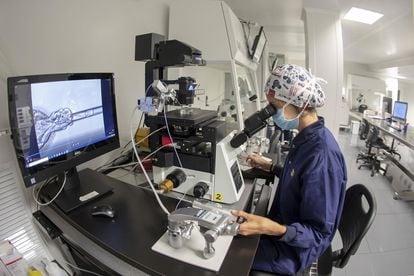
Spain was placed on the international map thanks to egg donation. “It continues to be the most important sector within this market,” explains Anna Molas, a postdoctoral researcher in Health Anthropology at the Autonomous University of Barcelona. Many women go to the clinic when it is too late to freeze their own eggs and this is the only alternative. The expert points out that there is an age and class bias in this practice, which she sees as problematic.
Another factor that has helped put Spain on the map is its legislation, which is more lax than in surrounding countries. “Here in the private sector there is no age limitation like there is in other countries. Nor are there hurdles for being a single woman, or a woman married to another woman. And also because of the anonymity [in the case of egg donation] which is no longer the case in most countries.”
Freezing eggs means pushing forward the biological clock, putting the decision to have kids on standby until you have enough economic, work or relationship stability. That’s what happened to Klaumann, who couldn’t find a stable partner or a job she liked. “Also, my desire to be a mother did not awaken until I was at least 35 years old. I was too busy living and enjoying my freedom,” she admits. Hers was an individual decision, but like all decisions, it was conditioned by her social background.
A woman’s eggs begin to lose quality at age 35, explains Antonio Urries, a biologist specializing in assisted reproduction and president of the ASEBIR association. Initially, patients’ eggs were only frozen if the women were undergoing radiotherapy, chemotherapy or removal of the uterus. “But its use has changed, it has progressed. In recent years, there has been a very significant increase due to age issues .” In this sense, the expert emphasizes the importance of educational work. “When a woman is considering her life project, just as she thinks about where she is going to live, and what job she would like to have, she should also consider her reproductive project.” Urries also underscores that this technique “is not a guarantee, it is an opportunity,” as it is not 100% effective. “It is very variable, and we cannot talk about a specific percentage. In 2020 there was one pregnancy for every 12 or 13 vitrified eggs, but it depends a lot on each case.” Klaumann’s personal experience, for example, does not fit into this statistic.
A medical response to a social problem
In 2014, major Silicon Valley companies began offering their female employees the possibility of financing egg freezing. Some critics said that this work incentive concealed a clear message to women: prioritize your professional career, postpone motherhood. However, the model has spread; today 20% of large American companies offer it as a benefit to their employees.
“The delay in motherhood hides a productivist impulse,” says Sara Lafuente Funes, an anthropologist specialized in oocyte vitrification. “It is the result of a society that places capitalist productivity at the center of society and leaves care and reproduction on the fringes.” In this context, she adds, egg freezing becomes a medical patch for a social problem, an individual solution to a collective situation. “In addition, it does so by creating another consumer product, turning reproduction into a market.”
Currently, Lafuente is investigating the social impact of this practice in the Cryosociety Project at the University of Frankfurt. “It is not a question of opposing those treatments. They represent progress, I know. But we should question the fact that they are not solving the problem, and that they are also generating inequalities, since not everyone can access them.”
In 2020, Kaia Nathalie Klaumann remarried and decided to start a family. It was time to use her frozen eggs. But the limitations on international travel due to the Covid crisis made her reject the idea of coming to Spain to be inseminated, so she asked for them to be sent to Texas. It was not a good idea.
The shipment was held up for a year due to bureaucratic and legal obstacles, and when she finally managed to have her eggs shipped, the logistics company lost them. “I used a code to follow where the package was, and I saw it until I stopped seeing it. Suddenly it disappeared,” Klaumann recalls with anguish. “I called and they didn’t know what to tell me, they even hung up on me.” After several days of searching, the package reappeared, but none of the 10 eggs it contained were viable. “No one can tell me the reason for sure, it’s something I can only suspect,” she laments.
Klaumann’s story has a happy ending. His name is Calvin and he is two years old. While fighting to get her frozen eggs, she had also started an in vitro fertilization process at a clinic in Texas, and this procedure was successful. Despite her unpleasant experience, she is a staunch advocate of egg freezing, and even of doing it abroad. Her only regret is that Covid, incompetence and a series of unfortunate events came together to ruin her plan. Like she says, echoing the experts: this is not a guarantee, it is an opportunity.
Sign up for our weekly newsletter to get more English-language news coverage from EL PAÍS USA Edition
More information

Why is penetration painful?
/cloudfront-eu-central-1.images.arcpublishing.com/prisa/I3I6MZKXZ5FW7CK64XGB5FGHY4.jpg)
The weight of words: Not all cancer is ‘cancer’
Archived in.
- Francés online
- Inglés online
- Italiano online
- Alemán online
- Crucigramas & Juegos

- Fertility Clinic in Madrid
- The Team & Fertility Specialists
- Emotional Support Unit
- IVF Clinic in Spain
- All Treatments and Techniques at Fertility Madrid
- In vitro fertilization (IVF)
- Artificial Insemination (AI)
- Reciprocal IVF (Shared motherhood)
- Egg donation
- Fertility Preservation
- Preimplatation Genetic Test (PGT)
- Anti-Müllerian Hormone Test (AMH)
- Frequently Asked Questions
- Frequently Asked Questions about Fertility
- Frequently Asked Questions about fertility preservation
- Frequently Asked Questions about fertility treatments
- Frequently Asked Questions about Embryo Transfer
Why is Spain the top destination for IVF treatment?
Spain is a leading country in IVF treatments . The extensive experience of our professionals and the specialization of the centers have made Spain one of the main countries where people travel for assisted reproduction treatments.
Furthermore, the fact that Spanish legislation is so comprehensive in the field of assisted reproduction is an added factor to all of the above.
Why is IVF more successful in Spain and why travel to Spain to receive it?
In recent years, Spain has emerged as a leading destination for couples seeking In Vitro Fertilization (IVF) treatment. With consistently higher success rates compared to many other countries, Spain has become an attractive option for those struggling with infertility. Below are the main reasons to travel to Spain for IVF treatment and why it is most successful in Spain:
1. Large number of donors
- In our country, the anonymity of donors has encouraged many young women and men to donate in order to help couples who are having difficulty conceiving.
- The existence of a large number of donors allows easy access to these assisted reproduction techniques, without long waiting lists or significant delays.
2. Extensive experience in genetics and laboratories with cutting-edge technologies
Spain has extensive experience in assisted reproduction techniques, and many fertility centers are highly specialized in performing IVF treatments.
In addition, a large number of IVF treatments with PGT ( preimplantation genetic test ) are performed. The centers have extensive experience in genetics and laboratories with cutting-edge technologies to perform embryo biopsies without harming the embryo.
3. Favorable legislation
Spanish legislation regarding assisted reproduction i s relatively favorable , allowing broader access to IVF treatments and greater flexibility in certain aspects of the process.
4. High success rate
The IVF success rate in Spain is high compared to other countries. In addition, our center , Fertility Madrid, surpasses the averag e.
5. Comprehensive approach
Fertility centers in Spain often take a comprehensive approach, providing emotional and psychological support to couples throughout the IVF process, which can have a positive impact on the results.
Spain, a global reference for reproductive tourism for IVF
In neighboring countries such as Italy or France, the laws do not authorize genetic screening of embryos. Therefore, many patients who wish to undergo these techniques turn to Spain as an efficient and accessible alternative .
In our country, the IVF ROPA Method (reception of eggs from the partner) for lesbian couples is also permitted. This treatment is not carried out in most EU countries, so many female couples travel to Spain to start their reproductive project and have access to ROPA Method.

Spain is undoubtedly a leading country in IVF treatment . The specialization of professionals and the high quality of the centers allow patients who decide to travel to find a safe place offering a wide variety of treatments, as well as professionals with great human qualities, eager to accompany patients on their reproductive journey.
Contact us now for obligation-free information
- Ask for information
- Request an appointment
- We’ll call you
Assisted Reproduction Treatments Artificial insemination (AI) In vitro fertilization (IVF) Egg donation Reciprocal IVF (Shared motherhood) Egg Donor Genetic or diagnostic tests Fertility preservation
I agree to receive commercial emails
I have read and accept the privacy politic .
What time do you prefer? Morning Afternoon
Reasons to trust our fertility clinic
Free Online Consultation Solve all your doubts!
Flexible timetable and without waiting lists to adapt to your lifestyle.
Tailor-made financing , contact us!

Spain, Czechia, Denmark and Belgium are the meccas of reproductive tourism
Barriers in many european countries push thousands of people abroad to access assisted reproductive technology (art) techniques. in some cases, they take out huge loans to pay for the treatments..
When Marie and her partner failed to conceive a baby for almost a decade, they ran into a wall. “We did a [gamete] donation procedure in France that didn’t work,” she says. At the same time they had to face another problem: the wait lists for assisted reproduction were two years long. “And when it doesn’t work, you have to wait another two years,” Marie points out. The delays made them fear the worst: ageing past the limit of 45 years old that France imposes on women for accessing ART . “If you can financially handle it, you’ll go to another European country which has the same assisted reproduction procedures, but faster,” she explains.
Marie, who traveled to Spain, is not unique. Erika (who, like Marie, uses a pseudonym in this story at her request), a Hungarian woman who has been trying to conceive with her partner since 2017, is also seeking access to egg donation . Although egg donations are possible in Hungary, the government requires the donor to be a family member. “I don’t have a relative who can donate an egg,” Erika says. This was the main reason that led her to cross the border to Slovakia, but the saturation and dehumanisation of the Hungarian health system also contributed, she says: “We feel like we are guinea pigs. We are primarily motivated to be treated as human beings and not to be like what we feel in Hungary to be put on a conveyor belt. Specifically, you didn’t even put on your pants, but the doctor was already on another patient.”
Sperm also travel
“A friend who is an embryologist told me they often had Danish donors at her clinic and I watched a programme called The Vikings are Coming about Danish sperm, so Denmark seemed to be a good place to start,” says Liv Thorne , who recounts her experience as a single mother in a recent book . She obtained donated semen in Denmark and had it sent directly to the UK. Why? Lack of supply: “In the UK it is not something that men commonly do, to donate sperm,” she explains to Civio . It is not the only country with supply problems: in Italy, according to 2018 data , 96.8% of imported sperm came from Spain, Denmark and Switzerland. “Transporting semen is relatively simple because a sperm sample spoils very little when freezing and thawing,” says Iñaki González Foruria , a specialist at the Dexeus Mujer fertility clinic. The same does not happen with egg donation since they are much more sensitive to freezing and many other factors. That makes it difficult for them to be kept in good condition in transport, so many people have to go abroad to obtain donated eggs.
A recent study reported that some 5% of European fertility care involves crossborder travel . The most popular European destinations are Spain, Czechia, Denmark and Belgium. In 2019, for example, Spanish fertility clinics carried out 18,457 treatment cycles for people from abroad, the majority from France and Italy, while Denmark performed more from 8,000 treatments for international patients, 21.69% of their total. In Belgium in 2018 13 out of every hundred cycles of in vitro fertilisation was for patients living outside the country, mostly other European Union member states. In contrast, in Lithuania between 2018 and 2020 the Ministry of Health counted only ten non-residents, most from Russia and Belarus, seeking ART.
What do people seek in each country?
The people Civio interviewed are a small fraction of the millions of users of assisted reproductive technology -some eight million babies have born thanks to these techniques— but for one reason or another they have felt forced to pursue ART far from home. The most common reasons are the multiple legal limits imposed in their home countries. Half of European countries prevent female couples from accessing ART and almost a third extend the ban to women who are single by choice. But there are also other barriers, such as age limits or the number of cycles financed. Other reasons include the long waiting lists , as in France, the need for higher quality or cheaper healthcare and sometimes a desire for anonymous donations .
In countries such as Hungary, where LGTBIQ+ couples are prohibited from using ART, foreign fertility clinics advertise their services to potential users. “In Czechia, in Ukraine and later in Austria, we could see that new institutions began to advertise for Hungarians in Hungarian just offering their services basically at the same price or very similar prices to the whole Hungarian private [sector],” says Bea Sandor , spokesperson for the Háttér Society . For Marie and her partner, language was not a barrier when they moved to Spain: “I don’t speak Spanish. But for French people it’s really easy. [Clinics that] take care of French patients speak French,” she says. According to gynecologist Marisa López Teijón , director of the Institut Marquès fertility clinic, her international patients “come from more than 50 countries.” It is also common for the most renowned clinics to open locations abroad.
Those who travel abroad in search of assisted reproduction choose where they will go according to their needs. This is what happened to Marie: “I live in Toulouse. It’s three hours away from Barcelona,” she says. Both Spain and Czechia are common destinations for people who have fertility problems and require donated eggs , as in her case. The data are overwhelming: 54.3% of treatments started in Spain in 2019 in foreign patients involved egg donation. The figures are also striking in Czechia: in 2017, the egg donors were residents (99.7%), while the recipients were mostly foreign people (86.3%).
More than half of donor inseminations in Denmark were made to foreign persons
In contrast, Denmark is famous for its sperm donors . In fact, according to the Danish Health and Medicines Authority , 55.5% of donor inseminations in Denmark were for foreign recipients. “Denmark is a relatively open country when it comes to sperm donor legislation,” says Lasse Ribergård Rasmussen , spokesperson for Cryos International , one of the most famous sperm banks. From their headquarters in Copenhagen -together with centres located in Cyprus and the United States- they send samples to 100 different countries worldwide. “Long waiting lists and legal aspects in the customers’ respective countries are also factors that can affect their decision,” Rasmussen says.
Loans to pay for treatments
Crossing the border implies, in most cases, a significant financial outlay . “Save every penny. Fertility treatment is very expensive,” Thorne says. Erika traveled to a clinic in Bratislava, Slovakia, instead of neighboring Czechia, to save money: she and her partner paid 4,000 euros for treatment, using a bank loan, instead of the 6,500-7,000 euros that they would have to pay in a Czech clinic. For her part, Marie estimates an expense of some 9,000 euros, counting the treatment and the three trips between Toulouse and Barcelona. “You have to be able to handle it,” she acknowledges.
Although the reasons for traveling to each place vary, all these countries have something in common. Permissive legislation and high success rates seem to have made them attractive destinations for thousands of people.
“Spain’s law, despite being older, has a very good permissiveness. The centres have been organized very well, they have achieved very good results, circuits and a way of functioning,” says González Foruria, the Dexeus Mujer gynecologist. “Spain, both in egg donation and freedom and having more facilities is one of the leaders in Europe”, says Juana Crespo , founder of the eponymous fertility clinic.
In the case of Czechia, according to the Institute for Health Information and Statistics , the reasons for this are similar: open legislation, the broad availability of anonymous donors and the quality of treatment. “Czechia is a popular IVF destination especially because it can offer both high success rates and affordable prices,” says Michaela Silhava , director of the Unica Clinic in Prague, Czechia. Most of his patients come due to legal restrictions, such as those in Italy, Germany and Austria, or because of long waiting lists, as in the United Kingdom.
However, the health authorities of Czechia fear that the arrival of too many international patients could make it difficult for those who live there to access assisted reproduction. This is clear from the 2017 report published by the Institute for Health Information and Statistics. The document warns of the risks of price increases and that ART treatments may become less accessible to residents of Czechia. Yet fertility specialists in Spain rule out that this could happen there because egg donation is also frequently used by people residing in the country and due to the competition between private clinics. As of publishing time, Civio has have not received a response on this matter from the fertility clinics contacted in Czechia.
What about the future?
An important question is whether the discrimination that still affects many people will end in the future. It is no longer just a question of access, but also of avoiding any type of subsequent exclusion. Like the one suffered by Chiara Foglietta and Micaela Ghisleni , a couple of Italian women who traveled to Denmark for artificial insemination. In April 2018, their son came into the world, as Foglietta, a Turin city councillor, wrote in a Facebook post . But, when registering him in the Civil Registry, the officials asked her to lie, to say that she had slept with a man. “There is no formula to say that you have done medically assisted reproduction,” Flogietta wrote .
Although they finally succeeded in registering the baby as the first registered child of two mothers in Italy , their experience is common. In Ireland, female couples who access assisted reproduction abroad cannot register the baby as the child of two mothers, according to a recent complaint by a family that moved to Belgium to conceive. In Hungary, where female partners cannot access artificial insemination or in vitro fertilisation, similar problems are common. “When the registration is taking place after the birth then the mothers are asked about whether there was a father. And if there’s obviously no father, then they have to tell something about the origin of the kid,” explains Sandor. Some people try to present documentation to prove that the baby was the result of ART, while others mention one-night stands and say they do not know the parent. “People [are] concerned about having to lie in front of a public notary . It’s something awful,” she says.
The situation in reproductive tourism host countries could change in the future. Irene Cuevas , coordinator of the Registry of the Spanish Fertility Society , points out that many women have traveled to Spain, especially to communities such as Catalonia and the Basque Country, for ART “because it was illegal” in their places of origin. However, the recent legislative change in France, which allows all women to access ART, regardless of their marital status or sexual orientation, will encourage such women to remain in their country. “The semen donation cycles will decrease above all,” says Cuevas. This could also happen in Belgium , another common destination for patients from France. For the French activist Magali Champetier , who traveled to Spain with her partner to have a baby, according to the magazine Komitid , “this will be less stressful, and in addition, it will be free, unlike abroad.”
European Data Journalism Network
This article is part of the European Data Journalism Network , a group of independent media organisations producing data-driven coverage of European topics. It is published under a CC BY-SA 4.0 license.
More information
Methodology
Olalla Tuñas and Miguel Ángel Gavilanes collaborated in this investigation. The journalist Adrian Burtin , from VoxEurop, conducted the interview with the French patient, whose contact was facilitated by the press office of the Dexeus Mujer fertility clinic. The journalist László Arató interviewed the Hungarian patient. The names of the two women have been changed at the express request of both. Information for Italy was provided by Giorgio Comai , from OBC Transeuropa.
We reviewed the scientific literature in databases such as PubMed and Google Scholar using search terms such as “reproductive tourism”, “fertility tourism” or “cross-border reproductive care”. We contacted the World Tourism Organization (UNWTO) which, despite publishing data on tourism for personal reasons , does not disclose information on health-related travel.
We contacted the press offices of the ministries of health or social affairs of all the countries of the European Union to request relevant reports or records. There is no specific data or we did not receive a response from Germany, Austria, Bulgaria, Cyprus, Croatia, Slovakia, Slovenia, Estonia, Finland, France, Hungary, Latvia, Malta, Netherlands, Poland, Portugal, Romania, Sweden. In the case of the United Kingdom, we reached the press office of the Human Fertilisation and Embryology Authority (HFEA). We did not rely on the figures published by the European Society for Human Reproduction and Embryology (ESHRE) in its annual publications, 2011 , 2012 , 2013 , 2014 , 2015 , 2016 and 2017 , because ESHRE indicates that the information is “incomplete” and “not reliable enough to draw conclusions”.
We did not receive responses from the Public Gamete Bank of Portugal, the Repromeda Clinic in Czechia, the European Sperm Bank in Denmark, or the Homophobie organization in France. The IVI-Valencian Infertility Institute in Spain declined to answer all of our questions and the Unica Clinic in Czechia answered only some of our questions.
Déjanos decirte algo…
En esta información, y en todo lo que puedes leer en Civio.es, ponemos todo el conocimiento acumulado de años investigando lo público, lo que nos afecta a todos y todas. Desde la sociedad civil, 100% independientes y sin ánimo de lucro . Sin escatimar en tiempo ni esfuerzo. Solo porque alguien tiene que hacerlo.
Si podemos informar así, y que cualquiera pueda acceder sin coste, sin barreras y sin anunciantes es porque detrás de Civio hay personas comprometidas con el periodismo útil, vigilante y al servicio de la sociedad en que creemos, y que nos gustaría seguir haciendo. Pero, para eso, necesitamos más personas comprometidas que nos lean. Necesitamos socios y socias. Únete hoy a un proyecto del que sentir orgullo .
Podrás deducirte hasta un 80% de tu aportación y cancelar cuando quieras.
¿Aún no es el momento? Apúntate a nuestro boletín gratuito.
Periodismo y acción para vigilar lo público
Gobiernos transparentes y personas informadas . Eso queremos y no podemos lograrlo sin tu apoyo.
¿Quieres re-publicar esta historia en tu medio? Es muy fácil. Solo tienes que copiar y pegar en tu gestor de contenidos el código html que ofrecemos a continuación y cumplir los siguientes requisitos :
Atribuye el artículo a su autor original , idealmente en la firma del mismo . Usa la forma: Nombre del autor/a, Fundación Civio . Si tu CMS no permite esta forma de atribución, añade la firma al inicio del artículo.
No puedes realizar cambios en la información , excepto para adaptar localizaciones, giros idiomáticos o tiempos a tu libro de estilo. (por ejemplo, “Cataluña” por “Catalunya”, “ayer jueves” o “el pasado jueves” por “ayer”). Nosotros respondemos por la veracidad del texto, desde su titular hasta su punto final. En caso de duda, contacta con el autor del texto.
Enlaza al artículo original e incluye todos los enlaces del texto .
No puedes utilizar programas o scripts para automatizar la re-publicación de todas nuestras historias , porque entonces no estarías re-publicando, estarías duplicando nuestra web. Selecciona los contenidos que sean de interés para tus lectores.
Más información sobre nuestras condiciones de re-publicación .

Spain, Czechia, Denmark and Belgium are the meccas of reproductive tourism
Barriers in many European countries push thousands of people abroad to access assisted reproductive technology techniques. In some cases, they take out huge loans to pay for the treatments.
Ángela Bernardo , Eva Belmonte , María Álvarez Del Vayo , Carmen Torrecillas – Civio

Photo: Javier Sánchez Salcedo/Flickr ( CC BY-NC-ND 2.0 )
When Marie and her partner failed to concieve a baby for almost a decade, they ran into a wall. “We did a [gamete] donation procedure in France that didn’t work,” she says. At the same time they had to face another problem: the wait lists for assisted reproduction were two years long. “And when it doesn’t work, you have to wait another two years,” Marie points out. The delays made them fear the worst: ageing past the limit of 45 years old that France imposes on women for accessing ART . “If you can financially handle it, you’ll go to another European country which has the same assisted reproduction procedures, but faster,” she explains.
Sperm also travel
“A friend who is an embryologist told me they often had Danish donors at her clinic and I watched a programme called The Vikings are Coming about Danish sperm, so Denmark seemed to be a good place to start,” says Liv Thorne, who recounts her experience as a single mother in a recent book . She obtained donated semen in Denmark and had it sent directly to the UK. Why? Lack of supply: “In the UK it is not something that men commonly do, to donate sperm,” she explains to Civio . It is not the only country with supply problems: in Italy, according to 2018 data , 96.8% of imported sperm came from Spain, Denmark and Switzerland. “Transporting semen is relatively simple because a sperm sample spoils very little when freezing and thawing,” says Iñaki González Foruria , a specialist at the Dexeus Mujer fertility clinic. The same does not happen with egg donation since they are much more sensitive to freezing and many other factors. That makes it difficult for them to be kept in good condition in transport, so many people have to go abroad to obtain donated eggs.
Marie, who traveled to Spain, is not unique. Erika (who, like Marie, uses a pseudonym in this story at her request), a Hungarian woman who has been trying to conceive with her partner since 2017, is also seeking access to egg donation. Although egg donations are possible in Hungary, the government requires the donor to be a family member. “I don’t have a relative who can donate an egg,” Erika says. This was the main reason that led her to cross the border to Slovakia, but the saturation and dehumanisation of the Hungarian health system also contributed, she says: “We feel like we are guinea pigs. We are primarily motivated to be treated as human beings and not to be like what we feel in Hungary to be put on a conveyor belt. Specifically, you didn’t even put on your pants, but the doctor was already on another patient.”
A recent study reported that some 5% of European fertility care involves crossborder travel. The most popular European destinations are Spain, Czechia, Denmark and Belgium. In 2019, for example, Spanish fertility clinics carried out 18,457 treatment cycles for people from abroad, the majority from France and Italy, while Denmark performed more than 8,000 treatments for international patients, 21.69% of their total. In Belgium in 2018 13 out of every hundred cycles of in vitro fertilisation was for patients living outside the country, mostly other European Union member states. In contrast, in Lithuania between 2018 and 2020 the Ministry of Health counted only ten non-residents, most from Russia and Belarus, seeking ART.
What do people seek in each country?
The people Civio interviewed are a small fraction of the millions of users of assisted reproductive technology – some eight million babies have born thanks to these techniques – but for one reason or another they have felt forced to pursue ART far from home. The most common reasons are the multiple legal limits imposed in their home countries. Half of European countries prevent female couples from accessing ART and almost a third extend the ban to women who are single by choice. But there are also other barriers, such as age limits or the number of cycles financed. Other reasons include the long waiting lists , as in France, the need for higher quality or cheaper healthcare and sometimes a desire for anonymous donations .
In countries such as Hungary, where LGTBIQ+ couples are prohibited from using ART, foreign fertility clinics advertise their services to potential users. “In Czechia, in Ukraine and later in Austria, we could see that new institutions began to advertise for Hungarians in Hungarian just offering their services basically at the same price or very similar prices to the whole Hungarian private [sector],” says Bea Sandor, spokesperson for the Háttér Society . For Marie and her partner, language was not a barrier when they moved to Spain: “I don’t speak Spanish. But for French people it’s really easy. [Clinics that] take care of French patients speak French,” she says. According to gynecologist Marisa López Teijón , director of the Institut Marquès fertility clinic, her international patients “come from more than 50 countries.” It is also common for the most renowned clinics to open locations abroad.
Those who travel abroad in search of assisted reproduction choose where they will go according to their needs. This is what happened to Marie: “I live in Toulouse. It’s three hours away from Barcelona,” she says. Both Spain and Czechia are common destinations for people who have fertility problems and require donated eggs , as in her case. The data are overwhelming: 54.3% of treatments started in Spain in 2019 in foreign patients involved egg donation. The figures are also striking in Czechia: in 2017, the egg donors were residents (99.7%), while the recipients were mostly foreign people (86.3%).
In contrast, Denmark is famous for its sperm donors . In fact, according to the Danish Health and Medicines Authority , 55.5% of donor inseminations in Denmark were for foreign recipients. “Denmark is a relatively open country when it comes to sperm donor legislation,” says Lasse Ribergård Rasmussen, spokesperson for Cryos International , one of the most famous sperm banks. From their headquarters in Copenhagen -together with centres located in Cyprus and the United States- they send samples to 100 different countries worldwide. “Long waiting lists and legal aspects in the customers’ respective countries are also factors that can affect their decision,” Rasmussen says.
Loans to pay for treatments
Crossing the border implies, in most cases, a significant financial outlay. “Save every penny. Fertility treatment is very expensive,” Thorne says. Erika traveled to a clinic in Bratislava, Slovakia, instead of neighboring Czechia, to save money: she and her partner paid 4,000 euros for treatment, using a bank loan, instead of the 6,500-7,000 euros that they would have to pay in a Czech clinic. For her part, Marie estimates an expense of some 9,000 euros, counting the treatment and the three trips between Toulouse and Barcelona. “You have to be able to handle it,” she acknowledges.
Although the reasons for traveling to each place vary, all these countries have something in common. Permissive legislation and high success rates seem to have made them attractive destinations for thousands of people.
“Spain’s law, despite being older, has a very good permissiveness. The centres have been organized very well, they have achieved very good results, circuits and a way of functioning,” says González Foruria, the Dexeus Mujer gynecologist. “Spain, both in egg donation and freedom and having more facilities is one of the leaders in Europe”, says Juana Crespo , founder of the eponymous fertility clinic.
In the case of Czechia, according to the Institute for Health Information and Statistics , the reasons for this are similar: open legislation, the broad availability of anonymous donors and the quality of treatment. “Czechia is a popular IVF destination especially because it can offer both high success rates and affordable prices,” says Michaela Silhava , director of the Unica Clinic in Prague, Czechia. Most of his patients come due to legal restrictions, such as those in Italy, Germany and Austria, or because of long waiting lists, as in the United Kingdom.
However, the health authorities of Czechia fear that the arrival of too many international patients could make it difficult for those who live there to access assisted reproduction. This is clear from the 2017 report published by the Institute for Health Information and Statistics. The document warns of the risks of price increases and that ART treatments may become less accessible to residents of Czechia. Yet fertility specialists in Spain rule out that this could happen there because egg donation is also frequently used by people residing in the country and due to the competition between private clinics. As of publishing time, Civio has have not received a response on this matter from the fertility clinics contacted in Czechia.
What about the future?
An important question is whether the discrimination that still affects many people will end in the future. It is no longer just a question of access, but also of avoiding any type of subsequent exclusion. Like the one suffered by Chiara Foglietta and Micaela Ghisleni, a couple of Italian women who traveled to Denmark for artificial insemination. In April 2018, their son came into the world, as Foglietta, a Turin city councillor, wrote in a Facebook post . But, when registering him in the Civil Registry, the officials asked her to lie, to say that she had slept with a man. “There is no formula to say that you have done medically assisted reproduction,” Flogietta wrote .
Although they finally succeeded in registering the baby as the first registered child of two mothers in Italy , their experience is common. In Ireland, female couples who access assisted reproduction abroad cannot register the baby as the child of two mothers, according to a recent complaint by a family that moved to Belgium to conceive. In Hungary, where female partners cannot access artificial insemination or in vitro fertilisation, similar problems are common. “When the registration is taking place after the birth then the mothers are asked about whether there was a father. And if there’s obviously no father, then they have to tell something about the origin of the kid,” explains Sandor. Some people try to present documentation to prove that the baby was the result of ART, while others mention one-night stands and say they do not know the parent. “People [are] concerned about having to lie in front of a public notary. It’s something awful,” she says.
The situation in reproductive tourism host countries could change in the future. Irene Cuevas, coordinator of the Registry of the Spanish Fertility Society , points out that many women have traveled to Spain, especially to communities such as Catalonia and the Basque Country, for ART “because it was illegal” in their places of origin. However, the recent legislative change in France, which allows all women to access ART, regardless of their marital status or sexual orientation, will encourage such women to remain in their country. “The semen donation cycles will decrease above all,” says Cuevas. This could also happen in Belgium , another common destination for patients from France. For the French activist Magali Champetier, who traveled to Spain with her partner to have a baby, according to the magazine Komitid , “this will be less stressful, and in addition, it will be free, unlike abroad.”
Methodology
Olalla Tuñas and Miguel Ángel Gavilanes collaborated in this investigation. The journalist Adrian Burtin, from VoxEurop, conducted the interview with the French patient, whose contact was facilitated by the press office of the Dexeus Mujer fertility clinic. The journalist László Arató interviewed the Hungarian patient. The names of the two women have been changed at the express request of both. Information for Italy was provided by Giorgio Comai, from OBC Transeuropa.
We reviewed the scientific literature in databases such as PubMed and Google Scholar using search terms such as “reproductive tourism”, “fertility tourism” or “cross-border reproductive care”. We contacted the World Tourism Organization (UNWTO) which, despite publishing data on tourism for personal reasons , does not disclose information on health-related travel.
We contacted the press offices of the ministries of health or social affairs of all the countries of the European Union to request relevant reports or records. There is no specific data or we did not receive a response from Germany, Austria, Bulgaria, Cyprus, Croatia, Slovakia, Slovenia, Estonia, Finland, France, Hungary, Latvia, Malta, Netherlands, Poland, Portugal, Romania, Sweden. In the case of the United Kingdom, we reached the press office of the Human Fertilisation and Embryology Authority (HFEA). We did not rely on the figures published by the European Society for Human Reproduction and Embryology (ESHRE) in its annual publications, 2011 , 2012 , 2013 , 2014 , 2015 , 2016 and 2017 , because ESHRE indicates that the information is “incomplete” and “not reliable enough to draw conclusions”.
We did not receive responses from the Public Gamete Bank of Portugal, the Repromeda Clinic in Czechia, the European Sperm Bank in Denmark, or the Homophobie organization in France. The IVI-Valencian Infertility Institute in Spain declined to answer all of our questions and the Unica Clinic in Czechia answered only some of our questions.
László Arató (EUrologus) and Adrian Burtin (Voxeurop) contributed to this story.
Tags: Demographics , Health , Rights and equality
Licence: creative commons attribution 4.0 international (cc by 4.0), stay up to date with our newsletter, edjnet - the european data journalism network.
Website design © EDJNet - 2024
- Español ( Spanish )

- Migration and asylum
- Climate change
- Investigations
- Voxeurop Live
- Environment, climate and science
- Politics and democracy
- Editorial policy
- Our weekly email newsletter

Christelle Taraud: The feminicide continuum, ‘a war machine directed against women’

Europe’s stubborn addiction to deforested Argentinian soy

- Portuguese (Portugal)

The meccas of reproductive tourism in Europe
Barriers in many European countries push thousands of people abroad to access assisted reproductive technology techniques. In some cases, they take out huge loans to pay for the treatments.
- Eva Belmonte , Ángela Bernardo , María Álvarez Del Vayo , Carmen Torrecillas - CIVIO (Madrid)
- Translated by Lucas Laursen
Select a language
When Marie and her partner failed to concieve a baby for almost a decade, they ran into a wall. “We did a [gamete] donation procedure in France that didn’t work,” she says. At the same time they had to face another problem: the wait lists for assisted reproduction were two years long. “And when it doesn’t work, you have to wait another two years,” Marie points out. The delays made them fear the worst: ageing past the limit of 45 years old that France imposes on women for accessing ART (Assisted reproductive techniques). “If you can financially handle it, you’ll go to another European country which has the same assisted reproduction procedures, but faster,” she explains.
Marie, who traveled to Spain, is not alone. Erika (who, like Marie, uses a pseudonym in this story at her request), a Hungarian woman who has been trying to get a baby with her partner since 2017, is also seeking access to egg donation. Although egg donations are possible in Hungary, the government requires the donor to be a family member. “I don’t have a relative who can donate an egg,” Erika says. This was the main reason that led her to cross the border to Slovakia, but the saturation and dehumanisation of the Hungarian health system also contributed, she says: “We feel like we are guinea pigs. We are primarily motivated to be treated as human beings and not to be like what we feel in Hungary to be put on a conveyor belt. Specifically, you didn’t even put your pants back on, and the doctor was already on another patient.”
A recent study reported that some 5% of European fertility care involves crossborder travel
A recent study reported that some 5% of European fertility care involves crossborder travel. The most popular European destinations are Spain, Czech Republic, Denmark and Belgium. In 2019, for example, Spanish fertility clinics carried out 18,457 treatment cycles for people living abroad, the majority from France and Italy, while Denmark performed more than 8,000 treatments for international patients – 21.69% of their total. In Belgium in 2018 13 out of every 100 cycles of in vitro fertilisation was for patients living outside the country, mostly other European Union member states. In contrast, in Lithuania between 2018 and 2020 the Ministry of Health counted only ten non-residents, most from Russia and Belarus, seeking ART.
What do people seek in each country?
The people Civio interviewed are a small fraction of the millions of users of assisted reproductive technology – some eight million babies have born thanks to these techniques – but for one reason or another they have felt forced to pursue ART far from home. The most common reasons are the multiple legal limits imposed in their home countries. Half of European countries prevent female couples from accessing ART and almost a third extend the ban to women who are single by choice. But there are also other barriers, such as age limits or the number of cycles financed. Other reasons include the long waiting lists , as in France, the need for higher quality or cheaper healthcare and sometimes a desire for anonymous donations .
In countries such as Hungary, where LGTBIQ+ couples are prohibited from using ART, foreign fertility clinics advertise their services to potential users. “In Czechia, in Ukraine and later in Austria, we could see that new institutions began to advertise for Hungarians in Hungarian just offering their services basically at the same price or very similar prices to the whole Hungarian private [sector],” says Bea Sandor, spokesperson for the Háttér Society . For Marie and her partner, language was not a barrier when they moved to Spain: “I don’t speak Spanish. But for French people it’s really easy. [Clinics that] take care of French patients speak French,” she says. According to gynecologist Marisa López Teijón , director of the Institut Marquès fertility clinic, her international patients “come from more than 50 countries.” It is also common for the most renowned clinics to open locations abroad.
Those who travel abroad in search of assisted reproduction choose where they will go according to their needs. This is what happened to Marie: “I live in Toulouse. It’s three hours away from Barcelona,” she says. Both Spain and Czech Republic are common destinations for people who have fertility problems and require donated eggs , as in her case. The data are overwhelming: 54.3% of treatments started in Spain in 2019 in foreign patients involved egg donation. The figures are also striking in Czech Republic: in 2017, the egg donors were residents (99.7%), while the recipients were mostly foreign people (86.3%).
In contrast, Denmark is famous for its sperm donors . In fact, according to the Danish Health and Medicines Authority , 55.5% of donor inseminations in Denmark were for foreign recipients. “Denmark is a relatively open country when it comes to sperm donor legislation,” says Lasse Ribergård Rasmussen, spokesperson for Cryos International , one of the most famous sperm banks. From their headquarters in Copenhagen – together with centres located in Cyprus and the United States – they send samples to 100 different countries worldwide. “Long waiting lists and legal aspects in the customers’ respective countries are also factors that can affect their decision,” Rasmussen says.
Although the reasons for traveling to each place vary, all these countries have something in common. Permissive legislation and high success rates seem to have made them attractive destinations for thousands of people.
“Spain’s law, despite being older, has a very good permissiveness. The centres have been organized very well, they have achieved very good results, circuits and a way of functioning,” says González Foruria, the Dexeus Mujer gynecologist. “Spain, both in egg donation and freedom and having more facilities is one of the leaders in Europe”, says Juana Crespo , founder of the eponymous fertility clinic.
Permissive legislation and high success rates seem to have made some countries an attractive destination for thousands of people
In the case of Czech Republic, according to the Institute for Health Information and Statistics , the reasons for this are similar: open legislation, the broad availability of anonymous donors and the quality of treatment. “Czech Republic is a popular IVF destination especially because it can offer both high success rates and affordable prices,” says Michaela Silhava , director of the Unica Clinic in Prague, Czech Republic. Most of his patients come due to legal restrictions, such as those in Italy, Germany and Austria, or because of long waiting lists, as in the United Kingdom.
However, the Czech health authorities fear that the arrival of too many international patients could make it difficult for those who live there to access assisted reproduction. This is clear from the 2017 report published by the Institute for Health Information and Statistics. The document warns of the risks of price increases and that ART treatments may become less accessible to residents of Czech Republic. Yet fertility specialists in Spain rule out that this could happen there because egg donation is also frequently used by people residing in the country and due to the competition between private clinics. As of publishing time, Civio has have not received a response on this matter from the fertility clinics contacted in Czech Republic.
What about the future?
An important question is whether the discrimination that still affects many people will end in the future. It is no longer just a question of access, but also of avoiding any type of subsequent exclusion. Like the one suffered by Chiara Foglietta and Micaela Ghisleni, a couple of Italian women who traveled to Denmark for artificial insemination. In April 2018, their son came into the world, as Foglietta, a Turin city councillor, wrote in a Facebook post . But, when registering him in the Civil Registry, the officials asked her to lie, to say that she had slept with a man. “There is no formula to say that you have done medically assisted reproduction,” Flogietta wrote .
Although they finally succeeded in registering the baby as the first registered child of two mothers in Italy , their experience is common. In Ireland, female couples who access assisted reproduction abroad cannot register the baby as the child of two mothers, according to a recent complaint by a family that moved to Belgium to conceive. In Hungary, where female partners cannot access artificial insemination or in vitro fertilisation, similar problems are common.
“When the registration is taking place after the birth then the mothers are asked about whether there was a father. And if there’s obviously no father, then they have to tell something about the origin of the kid,” explains Sandor. Some people try to present documentation to prove that the baby was the result of ART, while others mention one-night stands and say they do not know the parent. “People [are] concerned about having to lie in front of a public notary. It’s something awful,” she says.
The situation in reproductive tourism host countries could change in the future. Irene Cuevas, coordinator of the Registry of the Spanish Fertility Society , points out that many women have traveled to Spain, especially to communities such as Catalonia and the Basque Country, for ART “because it was illegal” in their places of origin. However, the recent legislative change in France, which allows all women to access ART, regardless of their marital status or sexual orientation, will encourage such women to remain in their country. “The semen donation cycles will decrease above all,” says Cuevas. This could also happen in Belgium , another common destination for patients from France. For the French activist Magali Champetier, who traveled to Spain with her partner to have a baby, according to the magazine Komitid , “this will be less stressful, and in addition, it will be free, unlike abroad.”
László Arató (EUrologus) and Adrian Burtin (Voxeurop) contributed to this story.
👉 Original article on CIVIO
Was this article useful? If so we are delighted!
It is freely available because we believe that the right to free and independent information is essential for democracy. But this right is not guaranteed forever, and independence comes at a cost. We need your support in order to continue publishing independent, multilingual news for all Europeans.
Discover our subscription offers and their exclusive benefits and become a member of our community now!

Timothy Garton Ash , historian and journalist
Are you a news organisation, a business, an association or a foundation? Check out our bespoke editorial and translation services.
From the same investigation
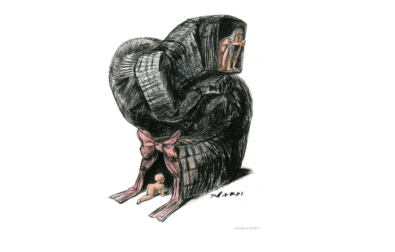
María Álvarez Del Vayo , Eva Belmonte , Ángela Bernardo , Antonio Hernández , Carmen Torrecillas - CIVIO (Madrid)
On the same topic
An official website of the United States government
The .gov means it’s official. Federal government websites often end in .gov or .mil. Before sharing sensitive information, make sure you’re on a federal government site.
The site is secure. The https:// ensures that you are connecting to the official website and that any information you provide is encrypted and transmitted securely.
- Publications
- Account settings
Preview improvements coming to the PMC website in October 2024. Learn More or Try it out now .
- Advanced Search
- Journal List
- Risk Manag Healthc Policy
Recent trends in reproductive tourism and international surrogacy: ethical considerations and challenges for policy
Raywat deonandan.
Interdisciplinary School of Health Sciences, University of Ottawa, Ottawa, ON, Canada
Reproductive tourism, or “cross-border reproductive care”, is the phenomenon of people crossing international borders to access reproductive technologies. One of the fastest-growing categories of cross-border reproductive care is international surrogacy, the act of infertile clients traveling internationally to engage the paid services of foreign surrogates to carry their babies to term. It is a multibillion-dollar global industry presenting unique legal, ethical, and risk-management challenges. Clients tend to be price-sensitive, middle-income individuals seeking services from surrogates who in the global market are thought to be of quite low socioeconomic status. Risks are experienced by all parties involved in the transaction, including the client’s countries of origin and destination. The risks to the surrogate evolve from the potential to exploit her economic vulnerability in order to encourage both consent and unfair pricing. Opportunities for policy development are explored.
Introduction
The global industry of commercial surrogacy – the phenomenon of women renting their wombs to clients for the purposes of creating babies – is estimated to be worth approximately $US6 billion annually. 1 When clients cross an international border to engage a paid surrogate, they are participating in the phenomenon of reproductive tourism, also called “fertility tourism”, “cross-border reproductive care” (CBRC), or “ reproductive exile”. 2 , 3 The phenomenon describes any travel to seek commercially provided assisted reproductive technologies (ARTs), which can include in vitro fertilization, preimplantation genetic diagnosis, gamete procurement, or a host of other services. However, the hiring of surrogate mothers presents particular challenges with respect to risk management, ethics, and the building of regulatory frameworks.
In India, which is fast becoming the global champion in providing commercial ART, surrogacy may be worth approximately $400 million annually, generated from the country’s approximately 3,000 specialty clinics. 4 The US is the other great provider of surrogates, with California and New Jersey leading the list of states that are home to surrogate births, each of which produce approximately 100 births per year. 5 Anecdotal evidence suggests that Thailand, Ukraine, and Russia are other popular sources of surrogates for an international clientele, while Mexico, Nepal, Poland, and Georgia are quickly gaining similar reputations. 6
Gestational surrogacy is distinct from traditional surrogacy in that the latter involves a pregnancy using the surrogate’s own ova, often involving artificial insemination, whereas the former necessitates reliance upon reproductive technologies to create embryos in vitro using external sperm and ova, which are then incubated by the surrogate. The distinction of gestational surrogacy is that the surrogate is not genetically related to the child being produced, theoretically making a commercial transaction less legally and emotionally problematic.
International surrogacy has gained popularity in recent years, due both to the inconsistency of international restrictions and to advances in technology allowing for easier gestational surrogacy. 7 Commercial surrogacy has been legal in India since 2002, but India’s surrogacy boon began in January 2004 with a grandmother delivering her daughter’s twins. 8 While many Indian ART clinics are hesitant to advertise the fact that they offer surrogacy services to foreign clientele, an analysis of Indian clinics’ websites concludes that “reproductive tourism comprises a substantial fraction of India’s assisted reproduction technologies clinics’ business focus, clustering around its most tourist-friendly locales, and surrogacy may be a strong motivator for international clientele”. 9
Information on the extent of surrogacy, either within a specific country or transnationally, is scarce indeed. This is due to the absence of a robust international reporting system. In the US, only gestational surrogacy tends to be reported, with almost no data available about the distribution or popularity of traditional surrogacy. 5 According to the Society for Assisted Reproductive Technologies, over 1,000 babies are born annually in the US via gestational surrogacy alone. 5 Meanwhile, approximately 5% of all European fertility care likely involves cross-border travel. 10

Motivations and drivers
Residents of wealthy nations are traveling to less wealthy ones in increasing numbers for the purposes of seeking medical care of all types. 11 While the exact size of the medical tourist population is unknown, anecdotal evidence places it in the hundreds of thousands to several millions yearly. 12 The number of those specifically seeking reproductive services globally is also unknown, but likely numbers in the tens of thousands in Europe alone 13 and (again anecdotally) in the hundreds of thousands in Asia.
Generally, the need to travel to seek reproductive services is shaped by a combination of legal restrictions forcing people out of their home countries and attractive services drawing patients to foreign countries to access those services. 14 The motivations for all types of medical tourism tend to be economics and availability in nature, meaning that lower costs of services abroad are an incentive, as is the opportunity to bypass either a service wait list or a domestic legal impediment to service. However, reasons for seeking cross-border care can be complex, and are dependent on the nature of the service sought. 15 CBRC seekers (“reproductive tourists”), therefore, may not resemble organ-transplant tourists or surgery tourists.
Medical tourists can be divided into two types: quality-sensitive and price-sensitive. The first type includes individuals who tend to be more affluent and are seeking better quality and more expensive care abroad. The second type tends to include those of the middle class who are seeking nonurgent procedures at reduced price. CBRC seekers are among the second type, though their motivation can transcend cost. Some nations, like Canada, forbid paid surrogacy. Therefore, for Canadians struggling to find an altruistic surrogate, travel to a more lenient jurisdiction becomes a prime motivator, regardless of cost.
Studies specifically exploring the motivations of CBRC seekers are few, but do reveal a nuanced pattern. A study in New Zealand 16 reported that CBRC clients from that country were motivated by the limited availability of gamete donors in their home jurisdiction, difficulty in meeting treatment-eligibility criteria, and the fact that some treatments were legally prohibited at home.
The legal prohibitions that enable CBRC are of two types: restrictions on who can access fertility care, and restrictions on what fertility care can be. 10 Restrictions on patient age, marital status, and sexual orientation are legally prescribed in some countries, which can motivate older, single, and homosexual individuals to travel for services. “By contrast, in some US states, strict non-discrimination laws prohibit ART clinics from denying care on the basis of a host of demographic factors, including race, ethnicity, marital status, and sexual orientation”. 10
Despite being motivated by a variety of factors, all CBRC seekers share three major characteristics: the desire for a child who is genetically related to them, the inability to produce this child through natural means, and a willingness to expend significant resources to produce the child. 17
The motivations and descriptions of surrogate mothers are less well studied. One scholar points out that “human body resources” are more available and affordable in low-income countries, where “poor and vulnerable” populations are both available in large numbers and are perceived as being more willing than citizens of wealthier countries to jeopardize their personal health for minimal financial reward. 11 It is thus speculated that the primary motivation of surrogates is financial, as Indian surrogates can make as much as $6,000 18 (compared to a typical American surrogate, who would earn $20,000), 19 which is substantially more than they would earn otherwise, though it is possible that feelings of altruism are also involved. Indeed, there has been some anecdotal speculation that the participation of Indian surrogates is motivated or encouraged by a religious desire to help lift the “curse” of infertility from their clients. 20
In fact, little is known about who the surrogate mothers in India are, as clinics are hesitant to share such data with researchers. However, there is some indication that they are likely poorly educated and of low social status. 21
There are some well-explored public health risks associated with ART in general, including the potential role of gametes as disease vectors. 22 Risks associated specifically with the gestational surrogacy industry are largely ethical, 23 economic, financial, and legal in nature, and can be divided into seven categories: 1) risks to the source country (the state of origin of the CBRC client); 2) risks to the destination country; 3) risks to the CBRC seekers; 4) risks to the surrogate mothers; 5) risks to the clinics and clinicians performing the ART procedures; 6) risks to brokering parties, such as medical tourism promoters, insurance companies, nongovernmental organizations, and health care workers with a peripheral interest in the surrogacy industry; and 7) risks to the children produced through surrogacy. This review does not consider the needs and experiences of actors in categories 5 and 6, as they have not been adequately studied, nor do they yet represent a substantial stake relative to those of actors in the first four categories. Category 7 will not be explored here either, as research on both the short- and long-term impact on children produced through surrogacy is scarce indeed, and rarely evolves past speculative, as in the case of the microchimerism example described later in this paper.
Risks to the source country
Risks experienced by the country of origin of the CBRC traveler are either of a legal or economic nature. Also, to the extent that regulatory issues reflect societal values, elements of the source country’s values system may also be affected.
Economically, one of the common arguments against any kind of medical tourism is that the traveler is spending his or her money in a foreign country rather than in their home jurisdiction. Their expenditure includes both payment for medical treatments and payment for services associated with travel. This is not an inconsequential amount, given the size and value of the industry, representing a loss of income opportunity for the source country.
Legally, if travelers are crossing borders to avoid restrictions in the source country, then that country’s ability and willingness to enforce its restrictions comes into question. There are instances in which states choose to prosecute their citizens who commit acts that are illegal at home but perhaps legal in the jurisdiction in which the act occurred. Most commonly, these instances are of a highly distasteful nature, such as child sex tourism, eg, the US Protect Act, 24 which allows for the legal prosecution of American citizens who purchase the sexual services of minors outside American soil.
It can be argued that the unwillingness of a state to enforce its statutes when citizens who violate them abroad return represents a tacit approval of the offending act. The fact that countries like Canada, where paid surrogacy is not permitted under the Assisted Human Reproduction Act, 25 nevertheless has a process for the adoption and conferring of Canadian citizenship upon children created by paid surrogacy abroad suggests that there is a disconnection between the extent to which the nation’s domestic law is assumed to reflect its society’s values and the extent to which such values are expressed in the actual enforcement of that law.
Risks to the destination country
Much like the risks posed by international surrogacy to the CBRC client’s source country, those experienced by the nation providing the reproductive services can be divided into three categories: financial, legal, and values-based. For a nation like India, which harbors a thriving and lucrative surrogacy industry, the financial benefits are substantial. However, it should be noted that while the medical expertise and resources were produced and paid for by Indian citizens, it is the foreign clientele that reap the rewards. This is one of the most common criticisms of all types of medical tourism: that a nation’s taxpayers should be the ones who benefit from the attentions of doctors whose education and infrastructural support were taxpayer-subsidized.
While a nation’s laws are ideally thought to mirror the values of its people, it is possible that a sufficiently powerful industry may influence those laws to reflect its needs instead. For example, Indian regulations hold that a gestational surrogate abandons all parental rights at the point of delivery, a rule that benefits the industry. In contrast, the US state of Michigan does not recognize surrogate contracts at all. 26 The extent to which the Indian practice reflects the values of its citizenry rather than those of the industry is unclear.
Moreover, the rapid growth of the industry and its globalized nature necessarily introduce practices and values from different countries into a milieu that may be culturally unprepared for such rapid change. An example is the case of a conservative Indian village woman bearing a child for two foreign gay men. Same-sex family-building would likely be a novel experience for the surrogate’s community. While it can be argued that such an experience is progressive and socially positive, it is nevertheless likely that its introduction was hastened by the presence of the reproductive tourism industry.
Risks to the CBRC seekers
People traveling internationally and spending large amounts of money to create their families are by their very nature vulnerable. They have typically struggled with biological infertility (or in the case of same-sex couples, social infertility) for many years, and have chosen the international surrogacy route after much travail. The threat is high for unsupported promises, by disreputable clinics and brokers, of high success rates, seamless legal procedures, uncomplicated surrogacy negotiations, and comfortable travel experiences.
As with all ART procedures, the commissioning couple risks creating a child with particular needs, as in the case of “baby Gammy” described herein. Most commonly, though, the risk is financial. As noted, CBRC seekers tend to be price-sensitive, and may be acquiring great debt on a venture whose outcome is not guaranteed.
Risks to the surrogate mothers
Risks to the surrogates can be of a social, legal, physical, or emotional type, and all can be placed somewhere on the continuum between respect for autonomy and exploitation of that autonomy. Acknowledging a woman’s right to use her body as she chooses can be framed as a celebration of her autonomy. Her actions may be distasteful to some, but a Western liberal ethical framework would nonetheless underscore her right to express her informed consent to participate in a commercial transaction involving her body, whether that participation comes in the form of physical labor, sexual services, organ or tissue donation, or commercial surrogacy.
On the other hand, given that surrogates (in low-income countries like India) are thought to be largely economically disempowered, it is rational to argue that their autonomy is being expressed from a space of desperation and thus vulnerability. To benefit from such autonomy can be described as the exploitation of desperation. The risks to economically and educationally disadvantaged surrogates, then, arise from their vulnerability to exploitation.
Humbyrd argues that concern for surrogates’ well-being can be divided into arguments about their welfare, commodification, and exploitation. The author further argues that “the only valid objection to international surrogacy is that surrogate mothers may be exploited by being given too little compensation”, leading to the recommendation that pricing standards be enforced, as a kind of “fair trade surrogacy”. 27
The biological risks to surrogates are those shared by all pregnant women, and in the case of ART procedures, there is a heightened risks for multiple pregnancies, which are problematic for both the surrogate and fetuses. Physiological outcomes of pregnancy can range on the spectrum of seriousness from migraines and back pain at the low end to diabetes, high blood pressure, or permanently impaired fertility further along to death in extreme cases. The emotional risk faced by all surrogates is the potential emotional attachment to a child that she must give away immediately after delivery. Postpartum concerns include scarring and other physical consequences from cesarean sections, as well as postpartum depression.
Additionally, economically poor surrogates in countries like India face particular social risks, including potential disapproval from their communities and rejection by their husbands. These types of risks are rarely, if ever, expressed in the informed-consent discussion, and ethically should be raised if autonomy is to be truly respected.
Legal pitfalls and the regulatory landscape
How a nation conceptualizes its version of the relationship between commerce and reproduction ultimately reflects that nation’s understanding of its own values. It also reflects the state’s understanding of its role and responsibilities with respect to its people. 28 The framing of laws on surrogacy simultaneously shapes the evolution of the surrogacy industry, and the laws themselves are shaped by that same industry. A nation with laws disfavoring the surrogate and favoring the client is a more attractive destination for a reproductive tourist seeking the fewest legal barriers. 23 For example, Michigan’s Surrogate Parenting Act 26 does not allow for recognition of surrogate-parentage contracts, meaning that the surrogate has strong rights regarding potential custody. Meanwhile, Indian law is robust in recognizing the legality of the surrogate contract, 29 thus providing more assurance for the client. Regulatory approaches must therefore dance upon the thin line between satisfying the public’s moral hesitation and empowering a potentially lucrative industry.
Guidance on establishing a nation’s legal narrative with respect to surrogacy, for signatory nations, must conform to the United Nations Convention on the Rights of the Child and the Hague Convention on the Protection of Children and Co-operation in Respect of Intercountry Adoption, both of which are focused on the fundamental rights of children and the obligation to prevent the abduction, sale, or trafficking of children.
Even with such guidance, the global regulatory framework is heterogeneous, with many nations having no federal statures at all. With respect to the key Western nations thought to be providing the bulk of clientele for international surrogacy (the US, Australia, Canada, New Zealand, Israel, and the UK), all except the US have a federal regulatory presence and distinguish between gestational and traditional surrogacy and between paid and unpaid surrogacy, with most choosing to criminalize the former but not the latter. 30 Policies concerning the repatriation of children produced by ART abroad vary widely, with some nations requiring the commissioning parents to legally adopt the produced child, even if that child is a genetic relative. One interpretation is that babies born to commercial gestational surrogates are stateless until adopted, meaning that simply being born in a country does not automatically confer citizenship of that country, thus freeing that state from much of the obligation to care for the child.
Israel was the first country to implement state-controlled surrogacy, wherein every surrogacy contract must be individually approved by the government; 31 under the “embryo carrying agreements law”, surrogates must be single, widowed, or divorced. In Georgia, surrogacy is legal, but the rules strictly prohibit surrogates from exercising any rights over the child. 32 Some countries, like Russia, require that there be a medical reason for surrogacy. 33
In Japan, surrogacy is banned outright. In fact, doctors, agents, and clients can be punished for commercial surrogacy arrangements. 34 Clearly, this prohibition does not extend to Japanese citizens traveling abroad for surrogacy services, as in the case of “baby Manjhi” described herein. The perception that surrogacy is fraught with biological risk may be driving Japanese society’s disapproval of the practice. 35
Meanwhile, in the People’s Republic of China, surrogacy was banned in 2001, though there are reports of a thriving underground black market for surrogacy services. 32 The Chinese approach is not surprising, given that country’s history of promoting policies to limit population growth.
In Saudi Arabia, religious authorities do not allow the use of surrogates, 34 which is to do with their interpretation of Koranic law. The role of surrogacy in Islamic cultures is a well-debated issue. In the majority Sunni interpretation, the participation of a third party to create a child is seen as a kind of adultery, 36 whereas in Shiite interpretation, surrogacy is permitted with the caveat that the sperm donor must be recognized as the true father. 37
India and Thailand are two of the few countries in the world where surrogacy does not exist in a legal desert; rather, it is overtly legal, up until 2015. In early 2015, however, Thailand made international news by overtly banning commercial surrogacy for foreigners 38 after a particularly problematic case involving an abandoned baby (“baby Gammy”, described herein) that had been commissioned by an Australian couple. 39
In India, meanwhile, while lawmakers have not yet made new law on the specific circumstances and requirements of either surrogacy or its related reproductive services and technologies, their most recent draft bill (2013) is a departure from the previous bill. 40 It indicates that their focus is on clinical matters, and not on the restriction or limitation on the scope or complement of service provision, a tack which is unlikely to diminish the flow of foreign clientele to Indian ART clinics. Activist groups accuse the government of structuring its bill to best service ART commercial interests and not sufficiently protecting Indian surrogates or properly reflecting the true sentiment or values of the electorate. 41 On its face, the bill exists to protect the rights and welfare of all players in the ART industry. However, its focus appears to be the avoidance of legal disputes over parentage for the purposes of easing international adoption procedures and thus lubricating the industry as a whole. 42
Policy discussions pertinent to India’s evolving regulatory frameworks tend to settle on a few constants. Among these are: no ART procedure should be performed without the client’s spouse’s consent; sex selection cannot be permitted except to prevent sex-based disease transmission; the surrogate should be a stranger to the commissioning couple; it should be prohibited to sell embryos and gametes outside of the country; it is preferable that the commissioning client(s) be a married couple; the surrogate should relinquish all parental rights over the child; it is highly desirable that the sperm originate only from either the male member of the commissioning couple or from an official sperm bank; 8 and donations from male acquaintances are seen as an unnecessary complication.
What remains to be seen is how India’s eventual law will consider same-sex parents, as reports famously suggest that a strong preference is being expressed for heterosexual parentage alone. 43 There is further uncertainty about whether age limits will be placed on surrogates, whether minimum compensation levels will be legislated, and whether additional criteria (beyond heterosexuality) will be required of the commissioning foreign clients. 44
From the perspective of those seeking to make the Indian surrogacy business less legally complicated (though not necessarily more ethical), additional desirable elements to any comprehensive bill include that: the specifics of any surrogacy arrangement should be governed by the text of the surrogacy contract signed by both the surrogate and the commissioning parent, which should be recognized in a court of law; the privacy of gamete donors must be protected; the birth certificate of the produced child shall only indicate the commissioning parents’ names, and not that of the surrogate; and that surrogacy contracts should include life insurance coverage in case of the death of the surrogate. 8
Attempts at legal harmonization in other parts of the world are focused on safety and quality standards. In Europe, this is driven by Directive 2004/23/EC, which outlines quality standards for human tissues and cells. 45 Factors that all frameworks must consider include: whether babies born from commercial surrogacy contracts are stateless (and thus must be adopted to obtain citizenship); whether a gestational surrogate qualifies as a parent, despite no genetic relationship; conversely, whether genetics alone are sufficient to confer parenthood; whether paid surrogacy conducted abroad constitutes a criminal breach if such action is illegal at home; the extent to which a commissioning client may exert the right of reproductive choice on a paid surrogate (see the abortion example of “baby Gammy” herein); whether marital status is a relevant qualification for the commissioning client, and subsequently what provisions exist when marital status changes in mid-procedure (see the example of “baby Manjhi” herein); whether marital status is a relevant qualification for a potential surrogate; whether traditional (nongestational) surrogacy can be permitted in a commercial milieu, given its potential to further complicate definitions of legal parenthood; whether surrogates may have legal standing in any form on the child’s birth certificate; and whether the conflict of interest manifest in a clinic acting on behalf of a client but performing medical procedures on a surrogate can be legally rectified.
Case studies and examples
A few famous cases have made international news, and have helped to frame some of the gaps in the local and global regulatory frameworks seeking to manage international surrogacy. The first landmark case was the 1987 birth of “baby M”, who was the product of traditional (nongestational) surrogacy in the US. Mary Beth Whitehead had contracted with William and Elizabeth Stern to act as a surrogate mother for them. She was impregnated with an embryo (made by her egg fertilized with Stern’s sperm). However, after delivering the baby, she sought to keep it as her own, in violation of the surrogate contract. The New Jersey Supreme Court ruled that “the government could not enforce a contract that orders a fit and loving mother to give away her child”. 46
In 2011, a similar case unfolded in the UK when a non-gestational surrogate fought to keep the child she had birthed, claiming that she feared for its safety once she learned of the commissioning parents’ violent tendencies. 47 Surrogacy contracts are legal in the UK, but are not necessarily legally binding in court. Much like the case of M, family courts seek to rule in the perceived best interests of the child, regardless of the clarity of the written agreement between the surrogate and clients.
In 2001, Marla and Steve Culliton hired Mellissa Carroll as a gestational surrogate in Massachusetts. 48 Despite Carroll not expressing any parental rights, the state court initially refused to add the genetic parents’ names to the child’s birth certificate, citing a tradition of only recognizing the woman who physically gives birth as the legal mother. The result was an eventual ruling that a gestational surrogate may enter into a binding agreement to forgo whatever parental rights she might have prior to the birth of the child, in contrast to the two cases described prior.
In 2008, the case of “baby Manjhi” made national news in India. A Japanese couple used a gestational surrogate with a donor egg, but then divorced before the baby was born. 49 The wife (who was not genetically related to the baby) did not want the child, but the husband (who was genetically related to the baby) did. However, at the time, Japanese law did not recognize surrogacy, and Indian law would not allow a single man to adopt a child. The case underlined the extent to which adoption and parentage laws continue to be slow to adapt to the circumstances presented by the new paradigm of assisted reproduction.
In 2015, “baby Gammy” was produced when an Australian couple, David and Wendy Farnell, commissioned a surrogate named Pattaramon Janbua in Thailand. The baby was diagnosed with Down’s syndrome, resulting in the couple not taking him back to Australia, even though his healthy twin sister was readily accepted. The international outcry was a primary reason for the subsequent changes in Thai surrogacy. 38 The Farnells had asked Janbua to abort Gammy, but she had refused, citing her Buddhist antiabortion beliefs.
That case highlights some of the moral imperatives involved in navigating surrogacy. Did Janbua have a legal and moral right to choose for or against abortion, given that such a procedure would be performed on her body, but also given that the baby was not genetically (or legally) hers? And were the Farnells justified in abandoning their parental responsibilities to care for Gammy, since their request for an abortion was denied? The circumstances necessitate a values-based examination of the extent to which progeny become property, and who ultimately has decision-making power with respect to the child’s interests.
The Gammy case was further complicated by revelations that David Farnell had been convicted and served prison time for child molestation. 50 This raised questions about whether clients need specific qualifications before being permitted to enter into a surrogacy contract or any sort of ART program that will allow them to become parents. Since laws around surrogacy tend to be constructed atop an adoption base, the use of qualification standards derived from adoption regulations is a reflexive choice. In adoption cases, the state routinely vets putative parents for suitability, citing a variety of economic and lifestyle factors, including whether a criminal record exists. These same state-mandated qualifications are not applied to those creating families without ART, as everyone is legally free to reproduce, regardless of his or her circumstance. The larger moral and legal question becomes whether babies born via ART are more similar to natural births or to adoptions.
With respect to the medical challenges posed by surrogacy, an interesting case study was presented by Loike and Fischbach, 51 who described a woman who was born with a kind of lymphoma that she had likely inherited from her mother and that her doctors feared would be transferred to her own children via her uterus. This is an example of maternal–fetal cell exchange, or microchimerism. The authors implied that the two-way nature of maternal–fetal exchange suggests that a surrogate carrying an embryo produced using this woman’s genetic material would be at risk for infection. Moreover, her case presents the possibility for surrogates who are in otherwise good health to pass on undiagnosed genetic issues to fetuses to which they are not genetically related, via an infection path for which doctors presently do not test.
Other notable cases involve women serving as surrogates to give birth to their own grandchildren. 8 , 52 , 53 These instances are interesting for their technological achievements and ethical and societal implications, though do not present challenges to any regulatory frameworks. A larger clinical risk concern emerges, though, when one considers the novel challenges of providing obstetric care for mothers who may be giving birth postmenopause.
Prospects for policy recommendations
CBRC in general, and international surrogacy in particular, must be understood as a global phenomenon requiring international frameworks and multinational data-collection paradigms. The European Union is taking a leadership role in exploring policy recommendations for managing international surrogacy among its member nations. 54 However, since CBRC, and medical tourism in general, is a genuinely global phenomenon, any policy directives will fall short unless consideration is taken of the roles of nations beyond just member states. National or continental regulations are meaningless unless states are also prepared to pursue their citizens who transgress abroad, which seems an unlikely path, given that one of main drivers of the industry is clients seeking to bypass legal restrictions at home.
The single greatest barrier to the development of policy regarding international surrogacy is the profound lack of reliable data on the phenomenon’s extent, distribution, and participants, even in well-resourced, well-monitored jurisdictions, such as the EU, where unlike other ART services there is no reporting standard for surrogacy, either nationally, internationally, or transnationally. 54 The establishment of an international surveillance system, with appropriate controls for patient confidentiality, would be an enormous contribution welcomed by policy makers, clinicians, brokers, and users alike.
A further policy opportunity is the exploration of the extent to which surrogacy should resemble the adoption standard. The regulatory frameworks described in this paper depend upon the validity of surrogacy contracts, whereas intercountry adoption tends not to be based upon contract, but upon larger child-welfare statutes. The adoption standard is important, as it provides a model for voiding a previous parent–child relationship. In one view, that is precisely the nature of a surrogacy arrangement: the transfer of the surrogate’s maternal relationship with the child to a relationship between child and client, necessitating the dissolution of the first relationship, but positive efforts need not be reserved for the legal class alone.
As Forman 55 writes, “CBRC and the subsequent fragmentation of fertility treatment is likely to increase and doctors must be drivers for improvement of standards of reproductive medical care in the developing world, and elsewhere, as more countries and clinics seek to benefit economically from the expanding market in medical consumerism”. This suggests that leadership must come from the clinical realm as well, and not necessarily just from the legal realm.
Where legislation fails, the adoption by clinics of ethical and transparency standards, especially surrounding the empowering of surrogate autonomy and negotiation power, can be a positive approach championed by clinicians independently of the state. ART clinics in India, for example, are currently expected to follow national guidelines, but are not yet subject to regulatory laws. Individual clinics can thus form “idiosyncratic policies regarding practice based on discretionary adherence to these guidelines with only the market and the management’s sense of responsibility”. 56
The encouraging of a high ethical standard among clinics can result in an improved commercial profile among clients seeking a transaction with minimal ethical conflict. A q uality standard, reflecting reduced risks to all agents, could be positioned as a competitive advantage and thus see wide adoption without the need for legal mandate. A related concept is Humbyrd’s “fair trade surrogacy”, 27 which is a proposal for a mechanism not only to minimize harms to all parties, but most notably to ensure fair compensation to surrogates, reflective of global standards.
As with all complicated global health phenomena, progress on the management of risk associated with cross-border surrogacy begins with the collection of high-quality data. The industry is yet young, as are the regulatory measures seeking to manage it, as well as the types and extent of studies seeking to understand it. While much uncertainty surrounds the moral, medical, and legal disposition of the participants, it seems undeniable that the phenomenon is nonetheless poised for substantial global growth.
The author reports no conflicts of interest in this work.
To read this content please select one of the options below:
Please note you do not have access to teaching notes, fertility tourism: a systematic review.
International Journal of Sociology and Social Policy
ISSN : 0144-333X
Article publication date: 10 April 2023
Issue publication date: 25 October 2023
The aim of this article is to review the literature on fertility tourism in terms of social policy implications. There has been a global growth in interest in fertility tourism, especially amongst these in developed countries travelling to developing countries for fertility needs. Due to women's increased involvement in the workforce and changing societal norms, the age at which females start having children has risen resulting in a need for many to seek fertility help. These developments have led to a growth in fertility tourism and related services.
Design/methodology/approach
The authors undertake a systematic literature review on fertility tourism to identify cognate research themes that relate to social policies such as assisted reproduction facilities, medical tourism and changing societal attitudes.
The findings of the study have important implications for social policy particularly regarding the tourism and health industry, practitioners and policymakers. This involves focussing on new geographic regions that are underrepresented in current research but have a high interest in fertility tourism. Currently much of the research is centred around western contexts but as evident in our review newly emerging markets in countries that have high infertility rates requires further attention. In addition, the authors provide directions for future research avenues that focus on how to evaluate changing social policies with regards to reproductive choices.
Originality/value
Whilst there has been much discussion in the media about fertility tourism there is limited knowledge about social policies related to human reproductive systems, so this article is amongst the first to discuss societal implications.
- Fertility tourism
- Medical tourism
- Systematic literature review
Strickland, P. and Ratten, V. (2023), "Fertility tourism: A systematic review", International Journal of Sociology and Social Policy , Vol. 43 No. 11/12, pp. 1156-1174. https://doi.org/10.1108/IJSSP-02-2023-0047
Emerald Publishing Limited
Copyright © 2023, Emerald Publishing Limited
Related articles
We’re listening — tell us what you think, something didn’t work….
Report bugs here
All feedback is valuable
Please share your general feedback
Join us on our journey
Platform update page.
Visit emeraldpublishing.com/platformupdate to discover the latest news and updates
Questions & More Information
Answers to the most commonly asked questions here
Tuesday, April 09, 2024
Tourism Review
Respected Voice of Tourism
- Weekly Travel News
REPRODUCTIVE TOURISM IN SPAIN BRINGS ABOUT 700 MILLION EUROS PER YEAR
‘Reproductive tourism’ is increasingly in demand around the world and Spain meets extremely optimal conditions to become a country of international reference. Currently, Spanish fertility and assisted reproduction processes have become one of the ‘meccas’ of reproductive tourism in the European Union. These services are in high demand, especially among medical tourists coming from the United Kingdom, Italy, France, and Portugal.
About 5% of the assisted reproductive treatments made in Europe are related to cross-border travel. In total, it is a business that moves almost 700 million euros in Spain every year.
According to the latest data from the National Activity Registry published by the Spanish Fertility Society (SEF) and the Ministry of Health, of the 127,420 in vitro fertilization cycles performed in Spain during 2020, 12,171 were for patients from abroad, mostly from France and Italy.
Reproductive tourism refers to foreigners who travel to Spain in order to receive fertility treatments. They are such as in vitro fertilization (IVF), and egg and sperm donation. It has already become a booming business in Spain and with a long way to go due to the economic business it generates.
Spain has high standards of healthcare quality and excellent training for its professionals. Therefore, thanks also to the high rates of pregnancy and healthy children, they have made Spain in recent years one of the main destinations for reproductive tourism in Europe and the world. In 2020, more than 152,000 assisted reproduction treatments were performed in the country, and around 10% were performed on foreign patients.
According to data from the Ministry of Health for 2020, assisted reproduction treatments in Spain have increased by almost 30% in recent years. The total value of assisted reproduction treatments carried out in Spain in 2021 was estimated at around 660 million euros. 75.7% correspond to privately owned specialized centers, 12.9% to public hospitals and 11.4% to private clinics.
Related articles
Luxury hotel investment in spain represents 37% of total, germans’ travel trends for the easter: egypt, spain, and turkey, spain welcomed 13.7 million foreign tourists in the first quarter of 2023, spain welcomes 50 million tourists this summer, spanish airports exceed pre-pandemic passenger figures, medical tourism in spain has a great potential, add comment.
- {{message}}
THE HOLIDAY TRAVEL INDUSTRY IN CHINA IS FLOURISHING
Cruise ships are back on track in germany, istanbul airport welcomed 70% of visitors, hotel technologies are reshaping the industry, latest reviews, tourism review online magazine 1 / 2023, tourism review online magazine 1 / 2022, tourism review online magazine 1 / 2021.
What is reproductive tourism?

Reproductive tourism is a type of medical tourism that refers to the practice of traveling to a foreign country to carry out fertility treatment. The main reason why a person or couple decides to move to another country to receive health care has to do with a lax legislation or the lack of the desired treatment in their country.
Below you have an index with all the points that we are going to deal with in this article.
Article Index
- 1. Definition
- 1.1. What is assisted reproduction?
- 1.2. What is surrogacy?
- 2. Most requested treatments
- 3. Assisted reproduction destinations
- 3.2. Other countries
- 4. Surrogacy destinations
Reproductive tourism, also called fertility tourism , is the practice of traveling to another country to carry out assisted reproduction treatments, among which in vitro fertilization (IVF), artificial insemination and gestational surrogacy, surrogacy .
Many experts consider it a subclass of medical or health tourism. It is estimated that the first trips abroad for this purpose occurred in the XNUMXth century to England to treat diseases such as gout, hepatitis or bronchitis.

The main reasons why a patient or patients are forced to travel to receive medical treatment are related to lax legislation, the lack of the required treatment or the search for cheaper prices than those available in their country of origin.
In fact, many are the people who have coined this type of tourism under the name "Reproductive exile" as a way of criticizing the few options that couples who suffer from infertility usually have, which is why they are forced to travel abroad to fulfill their dream of being parents.
What is assisted reproduction?
The term Assisted reproduction refers to the set of techniques used to treat the different infertility problems that today are increasingly common in couples around the world.
It should be clear that assisted reproduction involves the artificial manipulation of gametes (eggs and sperm) in any part of the reproductive process, from the woman's ovulation to the development of the embryo, through the formation of sperm. In Spain, it is regulated in accordance with the Law of Assisted Human Reproduction Techniques (TRHA).
Currently, the main reason why a couple may require assisted reproductive treatment has to do with the maternity delay , given that the average age to have a child ranges between 26 and 29 years.

Assisted reproduction was an unprecedented scientific revolution, as it changed the way a couple could access parenthood. Until almost the end of the 1978th century, people with sterility or infertility problems had no choice but to resign themselves or resort to adoption to start a family. All this changed after XNUMX thanks to the birth of the British Louise Brown, the first «test tube girl».
What is surrogacy?
For its part, surrogacy, commonly known as rent belly , is a reproductive alternative focused on those women who cannot have a child due to the inability to gestate. Likewise, surrogacy is a very suitable method for single men and male homosexual couples, since in this way they can have a biological child of their own.
A surrogacy process implies the presence of a woman outside the couple or person who undergoes the treatment. This woman is called pregnant or surrogate mother and is the one who agrees to bear the child of another person in exchange for financial remuneration or totally altruistic, depending on the country where this procedure is carried out. Intended parents are named after intentional parents .
To date, surrogacy is a non-generalized technique, so each country has its own regulations, either to allow it based on a series of requirements or to prohibit it.
This assisted reproductive technique not allowed in Spain in accordance with the Assisted Reproduction Law 14/2006, although nevertheless it is estimated that in this country there are currently between 1.000 and 1.400 babies who have been born by surrogacy in a foreign country, according to information provided by different Spanish associations. To learn more, we recommend you visit the specialized magazine Babygest .
Most requested treatments
Annually, it is estimated that between 20.000 and 25.000 couples and singles resort to reproductive tourism to start a family. As mentioned above, the main reasons for opting for this mode of conception are related to any of the following aspects of the country of origin: not very permissive legislation , excessively high prices or lack of treatment.

What are the most demanded treatments internationally? We show them below:
- Egg donation or egg donation
- Sex selection
- Artificial insemination with donor semen
It should be noted that reproductive tourism is also a widely demanded option among the LGBT collective and the women and men who decide to embark on the road to motherhood alone.
Thus, while surrogacy is popular among homosexual male couples, among lesbian couples there is a type of in vitro fertilization called CLOTHING method , in which one of the women gives her eggs to the other, who will be the one who carries the future baby. This treatment is allowed in Spain, although the couple must be married.

In the specialized magazine INVITE You can find information regarding egg, semen and embryo donation along with the requirements to carry out these treatments and international clinics.
Assisted reproduction destinations
These are the main countries that those interested in assisted reproduction usually travel to:
It is estimated that almost half of the IVF treatments with donor eggs carried out in Europe take place in Spain . Artificial insemination with donor sperm is another of the most popular treatments for British tourists traveling to Spain.

However, this trend began to change in the late 1990s and early XNUMXst century, when the donation limit was lowered by law to six per individual.
Currently, we find a significant number of quality clinics that carry out assisted reproduction treatments to people from all over the world, including Latin America.
Other countries
Israel It is currently the most requested country at an international level to carry out in vitro fertilization treatments, since it is the one with the largest number of assisted reproduction clinics in the world.
Secondly, the United States stands out mainly for being the favorite destination of the majority of European citizens due, on the one hand, to its high success rates and, on the other, to the flexibility of its set of laws in this field. In the US, donors receive a financial benefit for donating their eggs and can remain anonymous or, conversely, reveal their identity to the recipient partner or woman.

The fact that sex selection is allowed in United States It is something that is very attractive for the British tourist, basically because it is only possible through a technique known as preimplantation genetic diagnosis (PGD), which is not legal in the United Kingdom.
Anonymous egg donation is one of the main reasons why a large number of Canadian women travel to the US year after year to undergo this treatment. Likewise, egg donation is the treatment most demanded by Canadian women, since it is estimated that about 80% of their trips due to reproductive tourism are to carry out this technique.
Regarding sperm donation, Denmark It is the main destination for those women who seek to undergo artificial insemination with donor semen. Likewise, it is the leading country in the export of semen to other countries, which means that there is the possibility of buying semen through the Internet to carry out a home artificial insemination with donated semen. The destinations with the greatest demand for donor semen are: Paraguay, Canada, Hong Kong and Kenya.
Within Europe, the majority of citizens who travel abroad to undergo fertility treatment come from Germany and Italy, which are the most restrictive countries with regard to the number of eggs to fertilize and the number of embryos to transfer or freeze.
On the other hand, approximately 52% of American women travel to India and other Asian countries to undergo IVF treatment with an egg donor, due to the excessive prices of this treatment in the USA.
Surrogacy destinations
Surrogacy is not legal in a large number of countries, which is why it is one of the top treatments of so-called reproductive tourism. Although it is allowed in several countries, the truth is that the most requested are: United States, Russia , Ukraine and India.
In the United States, the main attraction of surrogacy is the high quality with which all procedures related to this treatment are performed. The preferred state for the international patient is California , given that its laws are probably the most permissive for both heterosexual couples and the LGBT community.

India has become popular in recent years because of its relatively low price compared to other destinations. Furthermore, the laws in India regarding surrogacy are quite flexible, although it has been banned since 2014 for gay couples and single people.
The permissive set of laws of Russia it is very attractive to "reproductive" tourists who choose it as a destination. Both egg donation and gestational surrogacy are completely legal in Russia and can even be carried out for purely commercial reasons, that is, to obtain financial gain. The main advantage is that international patients have the same rights as Russian citizens to carry out this treatment.
Ukraine also accepts surrogacy and is another popular destination because pregnant women are prohibited from claiming the maternity of the baby according to the Ukrainian Family Code. In this way, the fear in intentional parents that some kind of parentage problem may arise once the baby is born disappears.

Greece and United Kingdom are two other countries in which surrogacy is legal, although in the United Kingdom there are a large number of restrictions, among which the fact that there is no legal regulation that ensures future parents the right of filiation once baby born. In Greece, on the other hand, this treatment has been allowed for foreign citizens since 2014.
Surrogacy is also accepted in the Mexican states of Sinaloa and Tabasco. Until the end of 2015, Mexico was one of the destinations for reproductive tourism for this reason, but as of that date, the new regulations regarding surrogacy establish that only Mexican citizens may undergo this treatment.
This article has been shared 59 times. We have spent many hours collecting this information. If you liked it, share it, please:
Curiosities

Spanish Fertility Society (Sociedad Española de Fertilidad – SEF)
The Spanish Fertility Society (SEF) is a non-profit scientific society whose purpose is to promote studies on fertility and assisted reproduction . It is also responsible for advising the State Administration and other entities, as well as for disseminating knowledge.
It is one of the most important entities at the medical level and makes various documents related to human fertility available to the public.

Provided below is an index with the 9 points we are going to expand on in this article.
- 1. History of the SEF
- 1.1. Awards
- 2. Project objectives
- 2.1. Books and publications
- 3. Operating regulations
- 4. Success rates provided by the SEF
- 5. Bioethics consultation service
- 6. FAQs from users
- 6.1. What are the functions of the Spanish Fertility Society (SEF)?
- 6.2. Who can make up a SEF interest group?
- 6.3. Are there any requirements for the creation of SEF interest groups?
- 6.4. Under which law is the SEF regulated?
- 7. Recommended reading
- 8. References
- 9. Authors and contributors
History of the SEF
It was founded in 1953 by José Botella Llusiá, researcher and physician specialized in gynecology and obstetrics. This society was named Sociedad Española para el Estudio de la Esterilidad (Spanish Society for the Study of Sterility ) and became affiliated to the International Federation of Fertility Societies (IFFS) . Some of the important dates for the history of the entity are:
- In 1978 it was renamed the Spanish Fertility Society .
- In 1990 the Registry of Assisted Reproduction Techniques was created.
- In 1997 the SEF became a member of the National Standing Committee on Assisted Human Reproduction.
- In 2009 , an agreement was signed with the Spanish Ministry of Health and Social Policy on the transfer and management of data included in the registry.
- In 2014 , the first Official Journal of the SEF was published: Reproductive Medicine and Clinical Embryology (MEDRE).
In addition, the president of the SEF is a position that has changed since its creation and is currently chaired by Luis Martínez Navarro.
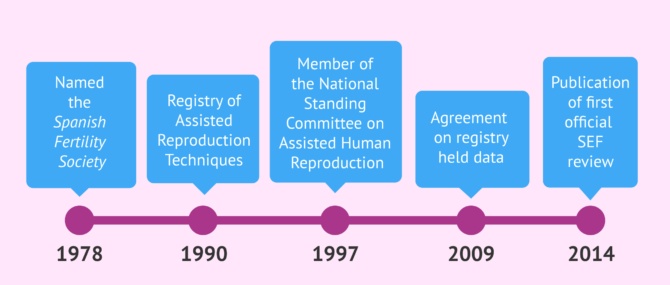
Throughout its years, the SEF has received several awards for its activity in the field of assisted reproduction and fertility. Some of these are indicated below:
- Quality Award in the National Health System in 2010. This was awarded for its publicly accessible information system for assessing the quality of care provided by assisted reproduction centers in 2010.
- Gold Star Award which was awarded by the Institute for Professional Excellence in recognition of its professional work and commitment to Excellence in 2015.
Project objectives
The main objective of the SEF is to promote studies and their application to social problems related to fertility. In addition, the SEF collaborates with the State Administration and other entities (associations, provincial corporations, foundations, etc.) related to reproductive health. The organization also advocates continuing education in Spain.
Finally, the SEF establishes and awards accreditations to Spanish fertility professionals or centers that meet quality requirements in terms of care and operation.
The SEF organizes the National Congress of the Spanish Fertility Society every two years.
Books and publications
The SEF, its interest groups and collaborators are responsible for publishing various works on fertility and reproductive biology. Thus, there are a multitude of publications and books that are useful for all those interested in the field of reproduction and fertility. Some of the documents are free of charge, while others must be paid for.
The following is a list of the most important publications:
- Management of the patient with endometriosis during childbearing age.
- Recommendations for the management of recurrent miscarriage .
- Impact of infertility and underlying endocrine pathologies on descendents.
- Manual of andrology.
- Implantation failure in assisted reproduction.
Operating regulations
Interest groups must have a defined structure with specific objectives and in accordance with the rules of the Board of Directors of the Company. In addition, the idea of working in collaboration with other interest groups allows the SEF to approach the functional structure of other scientific societies related to assisted reproduction. All this must be done without bureaucratization or causing a repetition of functions and tasks in the society.
We're already 773!
Join our inviTRA community
Success rates provided by the SEF
The success rates of assisted reproduction treatments are of great importance for patients, as they allow them to analyze the best clinic to go to in order to achieve pregnancy.
These data are published annually by the SEF, whose members are in charge of compiling all the results obtained by Spanish fertility centers and performing a statistical analysis. The latest report published by SEF shows the results for 2021 (2020 National Activity Registry-SEF Registry ).
The SEF represents the success rates differentiated into 3 age ranges of women. In addition, it takes into account whether the gametes are from own or donated origins, the implantation rate, the clinical pregnancy rate, delivery rate, and so on.
In summary, assisted reproductive techniques and their success rates include the following:
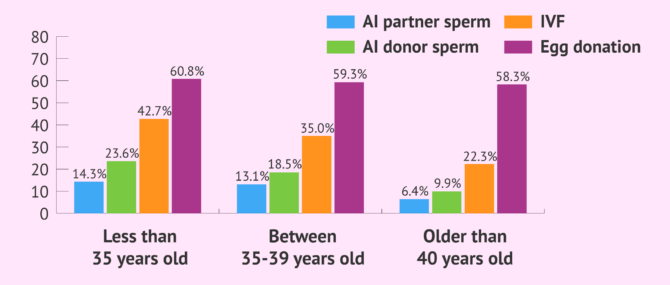
For more information on the success of the different assisted reproduction techniques, please visit the following link: An analysis of success rates of assisted reproduction treatments.
Bioethics consultation service
This service consists of counseling from a bioethical and legal point of view in the field of assisted reproduction, since the subject generates great controversy. It focuses on solving problems derived from the relationship with patients, professional responsibilities, gamete donation and so on.
It is a confidential service and subject to professional secrecy, so the information will only be known by the advisor providing the assistance. There will be no intermediary person.
FAQs from users
What are the functions of the spanish fertility society (sef).
The main functions of the SEF (Spanish Fertility Society) are: to promote the study of fertility, to organize and collaborate with different fertility societies and to support the study and research of infertility.
The SEF works closely with the Ministry of Health, Consumption and Social Welfare in the elaboration of the National Registry of Assisted Reproduction Activity. This guarantees that patients who receive assisted reproduction treatment are protected and protected within a framework of good medical practice.
Furthermore, the SEF has been driving and promoting the assisted reproduction sector in Spain for more than 60 years, which has placed this country among the most advanced in the reproductive sector. Read more
Who can make up a SEF interest group?
Membership in the Interest Groups is open to all SEF members who wish to join and request to do so. In this way, any member will be able to propose ideas for projects and receive news about other projects. This correspondence will be processed through the SEF secretary.
Are there any requirements for the creation of SEF interest groups?
The creation of Interest Groups should only take into account efficiency criteria aimed at avoiding excessive dispersion of efforts.
Under which law is the SEF regulated?
The SEF is generally governed by the Spanish Organic Law 1/2002, of March 22nd, which regulates the Right of Association. In addition, it is based on the different Statutes and the agreements of the General Assembly and the Board of Directors.
Recommended reading
If you want to know more about the different possilbilities to help you achieve pregnancy, you can visit the following link: Fertility treatments for couples: how to achieve pregnancy?
Alternatively, if you want to learn more about the success rate of IVF with donor sperm , we recommend that you read the article: IVF with donor sperm: process and success rates .
We make a great effort to provide you with the highest quality information.
🙏 Please share this article if you liked it. 💜💜 You help us continue!
Sociedad Española de Fertilidad. Registro Nacional de Actividad 2021-Registro SEF. ( Ver )
FAQs from users: 'What are the functions of the Spanish Fertility Society (SEF)?' , 'Who can make up a SEF interest group?' , 'Are there any requirements for the creation of SEF interest groups?' and 'Under which law is the SEF regulated?' .
Authors and contributors

Find the latest news on assisted reproduction in our channels.
Leave a Reply
Privacy Overview
What is Reproductive Tourism and Its Types?
Reproductive tourism occurs when people travel to access such reproductive technologies and services as (i) IVF; (ii) sperm and egg donation, (iii) sex selection and embryonic diagnosis, and (iv) surrogate parenthood. It also includes the converse: (i) abortion; (ii) contraception; and even (iii) vasectomies.
Technological change has enabled many decisions over many possibilities, from ‘test-tube babies’ to ‘designer children’ (notably by sex), with cloning perhaps waiting in the wings.
Like most forms of human behavior, reproduction appears to be a private and intimate affair. Yet, it is bound up in national policies (for example, abortion, provision of contraception, family sizes, and one-child families). Partly in response, reproduction has ‘gone global’ through transnational adoption (recently involving prominent film and famous music stars), fertility treatment, and reproductive tourism in what has been described as a ‘global market of commercial fertility.’
Types of Reproductive Tourism
Reproductive tourism may be divided into four types. These are followed as :
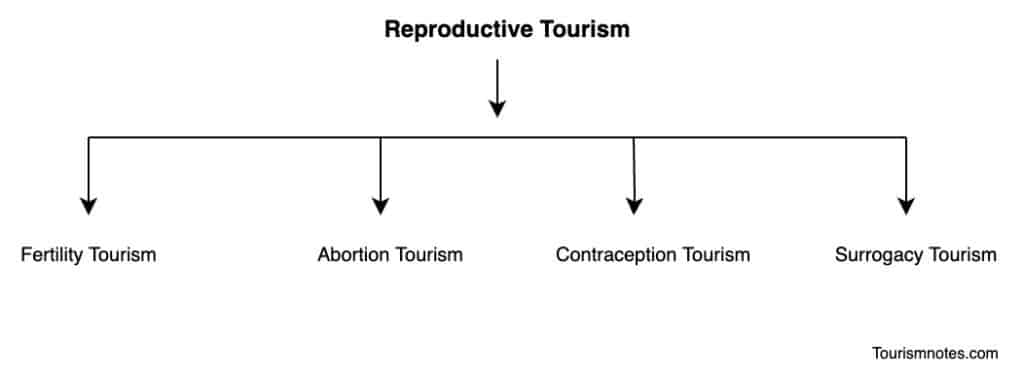
Fertility Tourism
Abortion tourism, contraception tourism, surrogacy tourism.

‘Fertility tourism’ involves access to overseas reproductive technology, enables cheaper, more efficient, or comprehensive services, and bypasses restrictive regulations, long waiting lists, legal constraints, and some- times high costs.
Such ‘global fertility tourists’ have consequently been seen as ‘desperate to break free from financial, legal, and ethical constraints.
Fertility centers exist in several countries, from the USA and Israel to small island states such as Cyprus and Barbados. Unlike other contexts where major ethical principles occur, some standard tourist potential is apparent, and it has even been called a ‘procreation vacation.’
Israel is a leading fertility tourism destination for IVF, with the highest global ratio of fertility clinics per capita. Still, the USA and Spain attract many Europeans because of higher success rates and lenient regulations.
Patients travel from countries like Germany and Italy, which are very restrictive over the number of eggs which may be fertilized and the use of donor eggs, or from Canada, where it is illegal to pay donors for eggs or sperm, or from countries like Costa Rica where it is virtually impossible to obtain eggs.
Countries such as the UK and Sweden, which only permit non-anonymous sperm donors, have a shortage of donors and long waiting lists (as long as six years or more in the UK) and are more likely to be marketed overseas for IVF procedures.
Over 250 Swedish sperm recipients annually travel to Denmark for insemination, partly because the insemination of single women is permissible. Parents seeking a particular gender for their children tend to go to the USA; parents from Australia, where gender selection is illegal, mainly travel there and face a starting price of at least US$25,000.
Somewhat differently from most forms of medical tourism , fertility tourism is centered primarily within developed counties that are the primary sources and destinations, involving high costs and perhaps as many as 20,000 couples a year.
As the website of one Spanish clinic states: ‘The present law governing assisted reproduction in Spain allows treatments to be carried out here which are restricted in other countries’ Countries seeking to establish medical tourism have offered procedures that would not pass scrutiny in many contexts; thus Georgia permits methods that are banned in Europe: surrogate egg donation and a database of surrogate mothers with photographs, a practice that would breach privacy restrictions in many countries.
What is possible in particular countries varies considerably, and even within Europe, there are critical differences between states, while attempts at regional regulation have been unsuccessful. Germany imposes strict limitations on access to reproductive technologies, whereas Israel offers firm support, and Ireland has significant constraints on abortion. Belgium and Italy have little legislation on assisted reproduction and are popular destinations within Europe.
That Spain and Slovenia are both significant destinations for egg procurement indicates no necessary correlation between Catholicism and lack of reproductive support.
New reproductive technologies raise ethical questions around individual and state responses to liberty, rights, and autonomy. Diagnostic tools screening for genetic disorders or sex raises questions about eugenics, screening for disability, and gender inequalities.
Third-party reproduction, such as surrogacy and sperm, embryo and egg donation, raise additional questions over parental rights and the commodification of bodies and babies, which have not been resolved in national contexts where they are permissible, even without venturing across international borders and into different cultural terrains.
Access to IVF, abortion, and contraception also raise religious and moral questions over ‘unnatural’ procreation and its termination, with some parallels in stem cell therapy, and over who might have access to technology (such as same-sex couples, older people, or individuals without partners).
By offering distinctive procedures in demand, countries that have not otherwise gained from medical tourism , such as Georgia and Vietnam, have attracted some visitors. Ukraine has also become a minor player by offering IVF services to gay couples and single. Parents, while age is no barrier either there or in India, twins are born to an NRI couple resident in Britain with a combined age of 131.
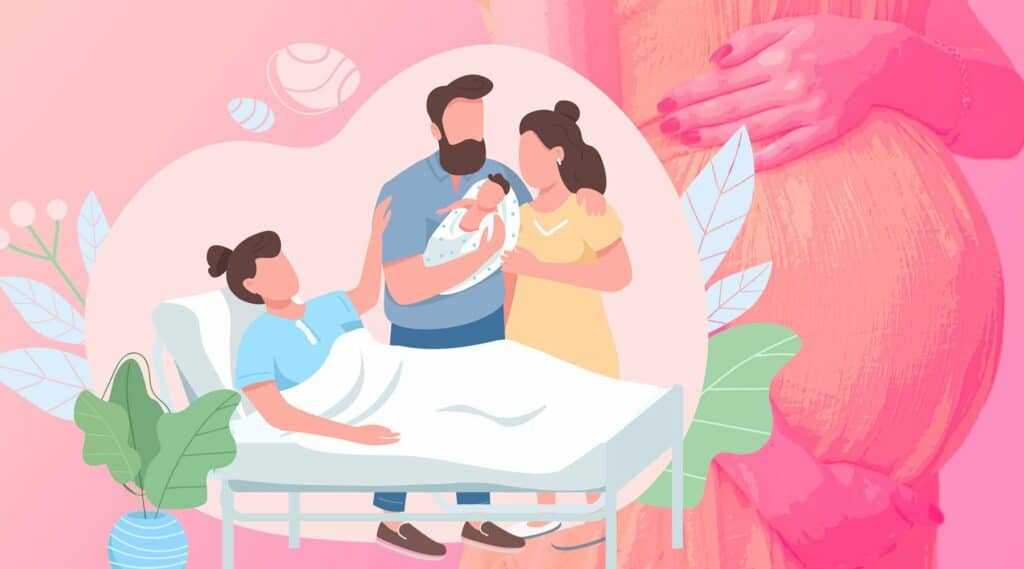
Surrogacy is primarily an Indian phenomenon. India has been seen as an ideal destination since Indian women rarely smoke and drink, and it more obviously offers ‘First World medical services at Third World prices. Accessing surrogate mothers in India assures the right of the intended parents to a supply of Asian donors, cheaper services, multiple embryo transfers, and sole parental rights, the last especially being impossible in home countries such as the UK or Australia.
Conversely, the surrogate parent has restricted rights, fewer than available in the source countries, in a high-risk context with perhaps limited economic gain and lost emotional attachments.
Commercial surrogacy has been legal in India since 2002, as it is in many countries, including the USA. Still, it has come closer there to being a viable industry rather than a rare fertility treatment’ so that ‘it could take off for the same reasons outsourcing in other industries has been successful: a wide labor pool working for relatively low rates in almost every large city, while prompting concern over ‘baby farms’ and ‘wombs for rent at meager cost, so transforming women into child-producing commodities.
Various Indian companies exist, some with evocative names such as ‘Babies and Us’ and ‘I wanna get pregnant”. At one small town in India, Anand (Gujarat), coincidentally known as ‘the milk capital of India,’ early in 2008, over 50 women, mostly poor villagers, were pregnant with the children of couples from the USA, Taiwan, Japan, Australia, the UK and elsewhere, at least some of whom were diasporic Indians.
Since then, surrogacy has expanded rapidly with an estimated 350 providers in India, some three times the number in 2005, enabling about a thousand attempts a year, a third from outside India.
Income generated from this in 2009 was estimated at as much as US$445 million. However, in 2010 the Australian government announced that it would not guarantee citizenship to surrogate babies born in India.
Australia Surrogacy, an MTC that organizes international surrogacy, stopped working in India because massive delays and citizenship requirements had become too onerous. Ethical issues merged with legal and constitutional questions to challenge the future of Indian surrogacy, at least in the case of Australia.
Surrogate mothers may earn significant sums, rising from about US$2500 in 2004 to over US$10,000, in big cities like New Delhi. Surrogate mothers in India make less than 10% of the overall expenditure on surrogacy, and their incomes are about 10% of those of surrogate mothers in countries like the USA.
However, surrogacy studies suggest that most surrogates are satisfied with their surrogacy experience, do not experience emotional attachments to the surrogate child, and feel generous about surrogacy even years afterward while earning incomes that are several times an average annual rural Indian wage.
Fears of surrogate mothers keeping babies have been unfounded. During surrogacy, women are usually given superior nutrition and medical care and housed in monitored circumstances to escape the stigma of surrogacy. Some women, however, may be forced into surrogacy by their husbands, and most volunteer only to escape grinding poverty.
Whether this will pose difficulties for some children who are visible of somewhat different ethnicity from their parents remains to be seen. Otherwise, debates over surrogacy parallel those over transplant tourism .
Despite the Indian focus, growing global complexities have emerged from the intricacies of surrogacy and reproduction:
Rudy Rupak, president of Planet Hospital, a California-based medical-tourism company, says that in the first eight months of this year, he sent 600 couples or single parents overseas for surrogacy, nearly three times the number in 2008 and up from just 33 in 2007.
All of the clients this year went to India except seven, who chose Panama. Most were from the U.S.; the rest came from Europe, the Middle East, and Asia, primarily Japan, Vietnam, Singapore, and Taiwan; because of growing demand from his clients for eggs from Caucasian women, he’s started to fly donors to India from the former Soviet republic of Georgia.
A Planet Hospital package that includes an Indian egg donor costs [US]$32,500, excluding transportation and hotel expenses for the intended parent or parents to travel to India. An egg package from a Georgian donor costs an extra [US]$5,000.
Even more complex global it is are evident. In 2007 a single Russian woman, a management consultant born in Pakistan, first sought to adopt a child in Germany, where she had citizenship. That was unsuccessful, and she moved to the UK to take advantage of the country’s more liberal attitude to single women who sought IVF.
After three years without success, she purchased sperm online from a Danish sperm bank retailing in New York, since purchasing in the UK would have involved a 3-year wait and considerable expense, and the sperm was used to fertilize the fresh eggs of an Indian woman in Mumbai. She was thus due to having a child of Danish- Indian genetic origin but knowing little of the two individual donors.

Where abortion is illegal or carries a heavy social stigma, pregnant women may travel to countries where they can terminate their pregnancy, which is called ‘abortion tourism.’
Technological change has transformed the mechanics, location, and ethics of reproduction. With rare exceptions, such as Malta, throughout the northern hemisphere, abortion is legal in certain circumstances. Still, availability ranges from ‘on demand’ to severely constrained, as in the mainly Catholic nations of Ireland, Poland, and Mexico.
Thus Polish women seeking to escape restrictive abortion laws travel to Ukraine or Belarus to terminate pregnancies. However, higher-income women travel to nearby EU countries, such as the Czech Republic and Slovakia, or more expensive Germany, Belgium, and Austria.
However, in 2007 as many as 31,000 Polish women had abortions in the UK, reportedly a 30% jump from previous years, but some may have been residents in the UK.
Just as in other components of medical tourism , reliable statistics are not surprisingly unavailable, though it has been estimated that in 2007 approximately 200 women per week were traveling to the UK from Ireland and Northern Ireland and that in 2006 just one Spanish clinic near the Portuguese border saw 4000 Portuguese women come to terminate pregnancies.
Several Western European countries have been destinations for women seeking abortions, notably Sweden and Spain, with Barcelona described as ‘Europe’s abortion mecca,’ where people from much of the continent could evade restrictions on late-term abortions. Class and socioeconomic status influence the ability to migrate and gain access to safe abortions.
Mexican women traveling to the USA for abortions were typically well educated and wealthy, came from Mexico City and more prosperous states, did not have to cross the border illegally, and could avoid clandestine and self-induced procedures. Poor women in Mexico, Ireland, and Poland were often in a socio-economic position where they could neither migrate nor gain safe abortions.
While such mobility has been strongly criticized in source countries where it breaches widely held moral positions and national legislation, it has also been criticized in destination countries for both the negative connotations of ‘abortion tourism’ for national identity, as occurred in Spain in the late 2000s and the local costs.
In 2010 there was resentment in the UK of an advertising campaign by a pro-abortion group in Poland that mimicked a Mastercard advertisement and offered ‘For everything you pay less than an underground abortion in Poland.’
Resentment centered on the view that foreigners used medical tourism, in this and other forms, to take free advantage of the NHS, which was estimated to have cost it £200million a year, giving rise to a degree of moral panic over the ownership and use of national services.
Similar moral panics have occurred in places as diverse as Thailand, New Zealand, and Australia. In certain circumstances, therefore, particular variants of medical tourism have been seen as being at some cost to national populations in lost income or displacing local people rather than as a boost to the national economy.
In its distinctive form, ‘abortion tourism’ has clear parallels with other forms of medical tourism. The rich can afford to travel further for care, while the poor are least likely to travel or cross nearby borders and may face complications (of various kinds) from not gaining access to adequate or any services.
Destinations are thus governed by cost. Anonymity is also essential. However, abortion tourism is confined mainly to middle-income and developed countries and is unrelated to diasporic tourism .

It is also called Birth control tourism. When women travel to seek treatment for birth control is called contraception or birth control tourism.
Contraception is globally more accessible than abortion, and moral objections to it are weaker and less widespread; however, though some techniques and supplies are unavailable in many countries, demand can be considerable.
Some MTCs thus advertise access to contraceptive services: Healthbase, in the USA, offers the implantation of intrauterine devices or their removal in Mexico, Costa Rica, or India.
‘ Birth control tourism’ appears to have been described just once; where in the early 2000s, the Mayor of Manila issued a total ban on contraceptives, and urban residents had to move elsewhere in the Philippines for access. The extent of international travel for access to contraception or vasectomies is unknown, but it plays some part in overall medical tourism .
Travel Safe

Spring time is here! Spain is filled with plans for you

Visit fairytale castles in Spain's most beautiful towns

15 spectacular blossoms to experience up close
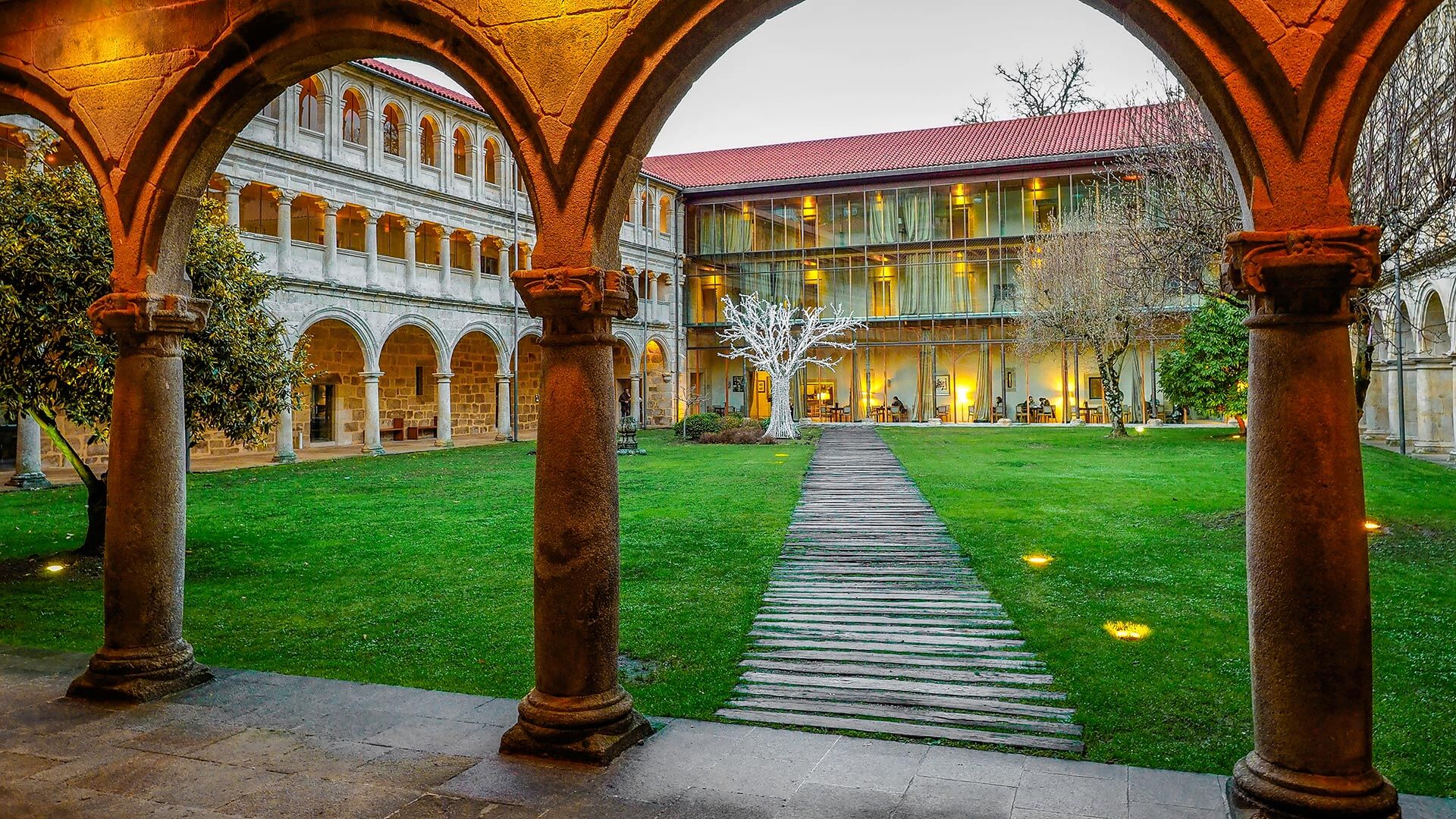
Route of the Monasteries in the Ribeira Sacra

Chillida, 100 years of the universal Basque artist

Start the route with the best music festivals
Discover our destinations

The capital city with a thousand options

One of Spain’s most avant-garde cities

A great city with lots to discover

A cosmopolitan vibe
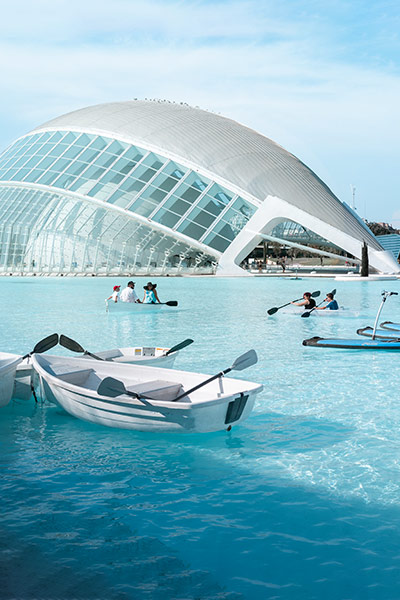
The essence of the Mediterranean

The capital of the Costa del Sol is reinventing itself

An inspiring destination

The final destination of St. James’ Way

The Golden city of a thousand legends

Ideal for a getaway

A picturesque medieval setting

European sunshine capital

Idyllic coves, beautiful sunsets...

Santiago de Compostela

Canary Islands

Balearic Islands

Not to be missed
Choose the travel plan you like the most to make your stay in Spain unforgettable

Holiday ideas in Spain, depending on how and with whom you travel

Museum Day is coming! Here are some ideas to make the most of it

Sport and adventure
Come for a multi-adventure outing! Do you dare?

Urban tourism
Cordoba: the city with four visits to places considered as World Heritage sites, packed with festivals in May

Prepare a family getaway to the countryside

Other ideas for your trip
Do you want some more suggestions for your holidays?

Most popular spain.info TikTok videos

Our 10 most-liked photos on Instagram

Rediscovering Madrid and Barcelona

Magical natural places in Spain
Are you sure you want to delete this route?

Route planner
Create your own plan for your trip to Spain with a route to suit your requirements
Enjoy the best events
Exhibitions, festivals, festivities... Don't miss a thing!

16 March 2024 - 03 May 2024
Cherry Blossom Festival

22 April 2024 - 05 May 2024
Tennis: Madrid Open

03 May 2024 - 05 May 2024
International Comic Fair

02 May 2024 - 12 May 2024
Festival of the Courtyards in Cordoba

17 May 2024 - 20 May 2024
Pilgrimage of El Rocío

30 May 2024
Corpus Christi in Toledo
All the useful information you need.
Trip advice to get the most out of your holidays
The weather in Spain
Today in: Ávila
How to get there
How to get around, practical information.

Book your experience
Thousands of activities thought out for you
#visitSpain
Share the best of Spain on our networks
The best ideas for travelling around Spain
Subscribe to receive monthly information with unique travel plans


IMAGES
VIDEO
COMMENTS
In Spain, Assisted Reproduction is governed by the Law 14/2006, considered one of the most comprehensive legal frameworks in Europe. PGD and anonymous egg and sperm donation are the main reasons why international patients seek fertility care in Spain. ... The so-called phenomenon of fertility or reproductive tourism. Most couples who decide to ...
Spain, leader in reproductive tourism. Wonderful weather, art and culture, delicious food and beautiful landscapes and beaches. Spain has been for years one of the favorite destinations for tourists from all over the world. It has also been one of the preferred countries for second residences and retreats. And now it is an ideal destination for ...
"People choose Spain as a reproductive tourism destination because their own countries have legal limitations that do not favor assisted reproduction," says Enrique Criado, who heads the Marbella-based center FIV. The rise of this kind of tourism can be explained by Spain's protective legislation, its good reputation in the field of ...
Spain - the leader in assisted reproduction treatment. Since 1978, the year that Louise Brown was born, the first in vitro fertilisation (IVF) baby, reproductive medicine has evolved by leaps and bounds. At present, Spain is the leading European country for the number of fertility treatments performed according to data from the European ...
Reproductive tourism. Around 16.000 children are born each year in Spain in assisted reproduction centers or clinics. 40% of them will not stay to live in the country, but will go with their parents to their countries of origin. It is a reflection of reproductive tourism, a trend increasingly present in the Spanish geography.
"That is why Spain is a leader in Europe, and I dare say that also worldwide, in matters of assisted reproduction." Spain has become an international beacon for reproductive tourism. EQUIPO JUANA CRESPO (Europa Press) Spain was placed on the international map thanks to egg donation.
Conclusion. Spain is undoubtedly a leading country in IVF treatment.The specialization of professionals and the high quality of the centers allow patients who decide to travel to find a safe place offering a wide variety of treatments, as well as professionals with great human qualities, eager to accompany patients on their reproductive journey.
A recent study reported that some 5% of European fertility care involves crossborder travel.The most popular European destinations are Spain, Czechia, Denmark and Belgium. In 2019, for example, Spanish fertility clinics carried out 18,457 treatment cycles for people from abroad, the majority from France and Italy, while Denmark performed more from 8,000 treatments for international patients ...
"Spain's law, despite being older, has a very good permissiveness. The centres have been organized very well, they have achieved very good results, circuits and a way of functioning," says González Foruria, the Dexeus Mujer gynecologist. ... The situation in reproductive tourism host countries could change in the future.
In 2016 alone around 140,000 cycles took place. Spain is also one of the main destinations of "reproductive tourism" or "cross border reproductive care" within Europe (Hudson and Culley Citation 2011; SEF Citation 2016, Citation 2017). Many reproductive treatments use third party biological material such as sperm, eggs or embryos.
A recent study reported that some 5% of European fertility care involves crossborder travel. The most popular European destinations are Spain, Czech Republic, Denmark and Belgium. In 2019, for example, Spanish fertility clinics carried out 18,457 treatment cycles for people living abroad, the majority from France and Italy, while Denmark ...
Fertility tourism (also referred to as reproductive tourism or cross border reproductive care) is the practice of traveling to another country or jurisdiction for fertility treatment, and may be regarded as a form of medical tourism. A person who can become pregnant is considered to have fertility issues if they are unable to have a clinical pregnancy after 12 months of unprotected intercourse.
Reproductive tourism, or "cross-border reproductive care", is the phenomenon of people crossing international borders to access reproductive technologies. One of the fastest-growing categories of cross-border reproductive care is international surrogacy, the act of infertile clients traveling internationally to engage the paid services of ...
Purpose. The aim of this article is to review the literature on fertility tourism in terms of social policy implications. There has been a global growth in interest in fertility tourism, especially amongst these in developed countries travelling to developing countries for fertility needs. Due to women's increased involvement in the workforce ...
This review analyzes the emerging literature on reproductive tourism through a metaphorical "reproscope," focusing largely on cross-border egg donation and surrogacy as the prime areas of contemporary anthropological investigation. While acknowledging that reproductive travel is not new, this article recognizes that there has been an increased volume of such travel over the past couple of ...
Reproductive tourism refers to foreigners who travel to Spain in order to receive fertility treatments. They are such as in vitro fertilization (IVF), and egg and sperm donation. It has already become a booming business in Spain and with a long way to go due to the economic business it generates. Spain has high standards of healthcare quality ...
Definition. Reproductive tourism, also called fertility tourism, is the practice of traveling to another country to carry out assisted reproduction treatments, among which in vitro fertilization (IVF), artificial insemination and gestational surrogacy, surrogacy. Many experts consider it a subclass of medical or health tourism.
History of the SEF. It was founded in 1953 by José Botella Llusiá, researcher and physician specialized in gynecology and obstetrics. This society was named Sociedad Española para el Estudio de la Esterilidad (Spanish Society for the Study of Sterility) and became affiliated to the International Federation of Fertility Societies (IFFS).Some of the important dates for the history of the ...
Reproductive tourism occurs when people travel to access such reproductive technologies and services as (i) IVF; (ii) sperm and egg donation, (iii) sex selection and embryonic diagnosis, and (iv) surrogate parenthood. ... with the highest global ratio of fertility clinics per capita. Still, the USA and Spain attract many Europeans because of ...
Thus, many couples travel to U.S. and Spain for reproductive tourism. Age Group Insights . The 35-44 segment dominated the market with a share of 42.6% in 2021. The high incidence of infertility in this age group is a key factor in the growth of the segment. The cost and anonymity of ART-assisted treatments are the main reasons for travel.
Tourist information about Spain: art, culture, museums, monuments, beaches, cities, fiestas, routes, cuisine, natural spaces in Spain | spain.info